|
29 Apr
2016 |
Domain change to www.integrisk.eu-vri.eu |
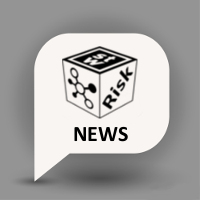 |
Dear all,
Starting from Tuesday, May 17, 2016, the www.integ-risk.eu domain will not be available anymore.
To access the webpage and applications please use www.integrisk.eu-vri.eu
Thanks for your cooperation |
|
|
|
|
|
14 Aug
2014 |
Final Assessment Report flags iNTeg-Risk as Success Story |
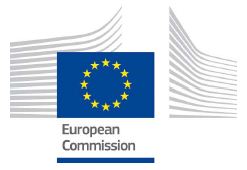 |
In its Final Assessment Report of iNTeg-Risk Project (www.integ-risk.eu) the European Commission flagged the project and the work of the consortium made up of 60 beneficiaries and 29 Third Parties as a "success story".
 |
In its Final Assessment Report of iNTeg-Risk (www.integ-risk.eu) the European Commission flagged the project and the work of the consortium made up of 60 beneficiaries and 29 Third Parties as a "success story" (the Report is available for Project Partners at http://www.integrisk.eu-vri.eu/home.aspx?lan=230&tab=533&itm=534&pag=594).
The EC explicitly highlights EU-VRi's project management ("outstandingly effective and efficient") for this complex large collaborative project which has received more than 12.5 Million EUR funding from 2008 to 2013.
The follow-up initiatives, such as the European Emerging Risk Radar (E2R2) or the European Common House Safety are underway and we are looking forward to build up on the results that have been achieved in iNTeg-Risk.
|
|
|
|
|
|
|
11 Jul
2013 |
Oil train disaster in Lac-Mégantic not just tragedy, but corporate crime |
 |
This recent accident was caused by a runaway train carrying crude oil which derailed and exploded in Lac-Mégantic, Quebec, resulting in at least 50 fatalities. At the root of the explosion is deregulation and an energy rush driving companies to take ever greater risks. Click here to watch a video showing the magnitude of this tragedy.
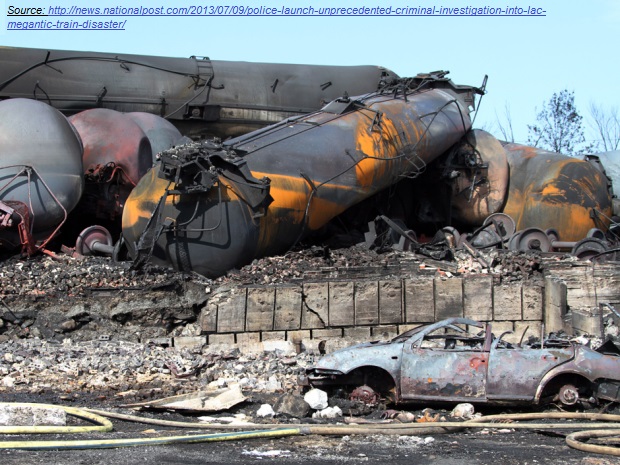
Source: http://news.nationalpost.com/2013/07/09/police-launch-unprecedented-criminal-investigation-into-lac-megantic-train-disaster/ |
The Lac-Mégantic derailment occurred in the town of Lac-Mégantic, Quebec on July 6, 2013, when an unattended 73-car freight train carrying crude oil ran away and derailed, as a consequence of which multiple tank cars caught fire and exploded.
Some of the key causes of this accident are weak regulation, poor inspection, "cowboy" attitude by the railroad owners as well as normalizing deviation.
The accident is indeed a lesson to be learned and it also demonstrates that strong, well-studied and applied regulations are required to prevent any similar incidents in the future.
Watch here a video showing the magnitude of this tragedy.
|
|
|
|
|
|
|
02 Jul
2013 |
OECD/iNTeg-Risk Workshop on Advanced Methods and Tools for Dealing with Systemic Global Risks |
 |
iNTeg-Risk supports system science and technology transfers as well as fosters collaboration between industry and the public sector, thus the High Level Risk Forum (HLRF) Secreatariat conducted a seminar on outputs of the HLRF at the 2013 iNTeg-Risk workshop. Click here to download the newsletter!
 |
The OECD/iNTeg-Risk Workshop on Advanced Methods and Tools for Dealing with Systemic Global Risks highlighted new development trends and tools for understanding and managing systemic risks and making sense of them for crisis managers.
Pierre-Allain Schieb presented the work of "Future Global Shocks" and an update related to the potential of space based technologies. Stéphane Jacobzone presented the G20/OECD framework for disaster risk assessment and financing, drawing on concrete examples and links to technologies.
The workshop was enriched with presentations from international experts on advanced methods and tools for risk management. Distinguished experts participating in the dynamic panel discussion included:
- Prof. Kenneth Oye, from the Center for International Studies at MIT,
- Dr. Nishimura from the University of Tokyo Japan, and
- Eric Rigaud from Mines Paris Tech.
Click here to download the newsletter!
|
|
|
|
|
|
|
26 Jun
2013 |
iNTeg-Risk CWA officially published by CEN today! |
 |
We are pleased to announce that the iNTeg-Risk CWA 16649 - "Managing emerging technology-related risks" has been officially published today! Order the document here.
 |
Today marks a big step towards a standardized approach for better management of emerging risks as the European Committee for Standardization (CEN) officially published the iNTeg-Risk CWA 16649 - "Managing emerging technology-related risks".
Order the document here.
|
|
|
|
|
|
|
27 May
2013 |
5th iNTeg-Risk Conference held on May 21-22, 2013 was a success! |
 |
The 5th iNTeg-Risk Conference held on May 21-22, 2013 in Stuttgart, Germany, successfully concluded where over 60 papers were presented at this year's conference. There were more than 130 participants who attended this event of the year for iNTeg-Risk project! Click here to find out more details about this exciting event.
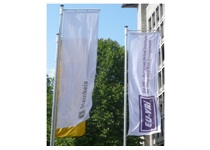 |
The 5th iNTeg-Risk Conference held on May 21-22, 2013 in Stuttgart, Germany, was a success where more than 60 papers related to the topics of this year's conference (management of emerging risks and related early warnings) have been submitted and presented at the event.
Furthermore, over 130 participants attended this event of the year for iNTeg-Risk project! The 5th iNTeg-Risk conference served as an excellent opportunity for project partners to communicate their results to the "outside world" and an opportunity for interested professionals, not participating in the iNTeg-Risk project, to learn about the project and its numerous results. This conference was partly dedicated to one of the ways for ensuring sustainability of the final project results: The European Emerging Risk Radar (E2R2) Initiative is envisaged as a platform enabling to recognize, monitor and manage emerging risks at the European level.
Click here to find out more details about this exciting event!
|
|
|
|
|
|
|
20 May
2013 |
Accompanying course to the 5th iNTeg-Risk Conference on the topic of ISO 31000 |
 |
The course 'ISO 31000 Principles and Management' was held just before the 5th iNTeg-Risk Conference 2013 on May 20, 2013. This course touched on the key elements in the International Standard of ISO 31000:2009; the complex relationship between risk management principles, frameworks and processes and the applications in industry and in general.
V-R32 ISO31000: 'ISO 31000 Principles and Management'
on May 20, 2013 in Stuttgart, Germany hosted and organized by R-Tech
Lecturer: Prof. Aleksandar S. Jovanovic, STI R-Tech
Venue: Steinbeis Transfer Institute Advanced Risk Technologies, Haus der Wirtschaft, Willi-Bleicher-Str. 19,
70174 Stuttgart, Germany
At the end of the course, students are expected to have basic knowledge about:
- main principles of the ISO 31000 standard
- ISO 31000 framework for managing risk
- implementation principles of the ISO 31000 standard
- related standards
- open issues in ISO 31000
- further development of ISO 31000 (ISO 31004, new revisions)
Course content by Units
|
Unit 1: Introduction to the ISO 31000 philosophy and principles
|
Duration
(minutes)
|
|
Explanation on the philosophy and basic principles of ISO 31000
|
60
|
|
Review and conclusions of the Unit 1. Questions and answers.
|
15
|
|
Unit 2: ISO 31000 Framework
|
Duration
|
|
Overview of the ISO 31000 framework for risk management
|
60
|
|
Review and conclusions of the Unit 2. Questions and answers.
|
15
|
|
Unit 3: Implementation principles of ISO 31000
|
Duration
|
|
Explanation on implementing the ISO 31000 risk management framework
|
60
|
|
Review and conclusions of the Unit 3: Questions and answers
|
15
|
|
Unit 4: Practical aspects of implementation
|
Duration
|
|
Elaboration on the practical aspects of implementing ISO 31000
|
60
|
|
Review and conclusions of the Unit 4: Questions and answers
|
15
|
|
Unit 5: Review and final discussion
|
Duration
|
|
Review of main course issues and final discussion
|
30
|
|
Closing the course
|
-
|
Announcement / Course Profile / Registration
Register before April 15, 2013 and you will receive a 10% discount from the registration fee! Final application deadline: May 6, 2013.
The course is intended for:
- professionals responsible for developing risk management policy within their organization
- professionals accountable for ensuring that risk is effectively managed within the organization as a whole or within a specific area, project or activity
- developers of standards / guides / procedures / codes of practice that, in whole or in part, set out how risk is to be managed within specific context(s)
- other professionals (engineers, managers, inspectors, legislators, etc.) who wish to deepen their knowledge in the field of risk management standardization
- individuals with no previous experience in the field of risk management standardization, but willing to extend their knowledge and take up new roles in this field within their companies
- university student
Direct contact: sti889@risk-technologies.com
Mr. Andras Veres
Tel: +49 711 1839 647
av@risk-technologies.com
Ms. Roswitha Kokejl
Tel: +49 711 1839 616
rk@risk-technologies.com |
|
|
|
|
|
15 May
2013 |
Summary paper for the iNTeg-Risk project! |
 |
A summary paper on iNTeg-Risk project was prepared for the 5th iNTeg-Risk Conference which was held on May 21-22, 2013. Click here to download this paper!
 |
A summary paper on iNTeg-Risk project was prepared for the 5th iNTeg-Risk Conference which was held on May 21-22, 2013. Below is an abstract of this summary paper:
The paper provides a summary of the achievements, and highlight the open issues and possibilities opening at the end of the European research project iNTeg-Risk (“Early Recognition, Monitoring and Integrated Management of Emerging, New Technology related Risks”). The project, joining efforts of 87 companies and organizations has delivered over 240 official deliverables (documents, software, demonstrators...), has fulfilled fully its work plan, and, at the same time, shown that there are a number of open issues, which will require further attention of the research community, institutions and industry in the future. As the basis for these future efforts, iNTeg-Risk has summarized its results in a set of major deliverables, labeled, at the end of the project by the developers, as the “Big 7” of iNTeg-Risk. They are: (1) iNTeg-Risk Catalogue of Emerging Risks – RiskEars system, (2) iNTeg-Risk Framework for Emerging Risk Management, (3) the library of iNTeg-Risk Methods, Handbooks and Guidelines for emerging risk analysis, (4) iNTeg-Risk dynamic library of emerging Risks Key Indicators (KPIs – Key Performance Indicators), (5) iNTeg-Risk CWA (CEN Workshop Agreement) document – the European pre-standardization document for Emerging Risk Management, (6) European Master and Certification in the area of Risk Engineering and Management – education and training for improved emerging risks management in the EU, and, (7) iNTeg-Risk Risk Radar & 1StopShop – the web-based prototype system-of-systems for early detection, recognition, monitoring and management of emerging risks. The paper puts the main deliverables into context of an overall improvement of the emerging risk management which took place in the last years, within and outside iNTeg-Risk project, and, in particular, to the improvements expected to contribute to the development of “risk radars”. In that sense, the project results definitely bring us “nearer to improved Early Recognition, Monitoring and Integrated Management of Emerging, New Technology related Risks”.
To read more, click here to download the full paper.
|
|
|
|
|
|
|
22 Apr
2013 |
Learn about robust decision making in risk management |
 |
The SHB/iNTeg-Risk course 'Decision Aid Approaches for Risk Management' is organized on April 22 - 26, 2013 in Stuttgart, Germany. The participants benefit from the course by acquiring the basic knowledge about 1) main concepts related to decision making in risk management; 2) key decision making moments of risk management frameworks; and 3) tools available to improve the way managers are dealing with decision making.
VF-R39 DAA: 'Decision Aid Approaches for Risk Management'
on April 22-26, 2013 in Stuttgart, Germany hosted by the International Center for Culture and Technology Research at the University of Stuttgart and organized by R-Tech
Lecturer: Dr. Chabane Mazri, INERIS - Institut National de l'Environnement Industriel et des Risques (France)
Venue: Internationales Zentrum für Kultur- und Technikforschung (IZKT), Geschwister-Scholl-Straße 24, 70174 Stuttgart, Germany
Decision making is a process where multiple factors interact to shape the final outcome. Those factors can be technical, informational, emotional/psychological, cultural… Nevertheless, the limited rationality of economic operators makes the decision exercise more and more difficult in a more and more complex world. Safety management requires short, mid and long term decisions that may highly influence the ability of the organization to cope with its risks.
Course content by Units
|
Unit
|
Title & contents in brief
|
|
1.
|
Introduction to decision making in risk management
- Present how decision making may shape the way organization deals with risk. Through the study of various risk management frameworks (IRGC, ISO31000).
- Stakes and challenges associated to those critical phases will be highlighted.
|
|
2.
|
Reference models
A global presentation of the way decision making is considered through different disciplines and theoretical frameworks. At the end of this second phase, the students will develop a good overview of the reference models and theories related to decision making.
|
|
3.
|
Methods and tools
The scope of decision support tools is large. This section will introduce the most frequently used tools and methods within organizations dealing with risks.
Highlights will be given to:
- Multicriteria approaches like ELECTRE and Multi Attribute Utility Theory.
- Methods to elaborate and choose Key Performance Indicators for risk management.
- Uncertainties management in decision making.
|
Announcement / Course Profile / Registration
The registration is free of charge, anyone interested in the topic are welcome on the course. Please note, however, that the course is intended for 20-25 participants. The registrations will be processed on the first-applied-first-served basis. Final application deadline: April 15, 2013.
The course targets attendees with inimum mathematical background and openness to psychological and behavioral approaches of decision makin.
Direct contact: sti889@risk-technologies.com
Mr. Andras Veres
Tel: +49 711 1839 647
av@risk-technologies.com
Ms. Roswitha Kokejl
Tel: +49 711 1839 616
rk@risk-technologies.com |
|
|
|
|
|
19 Apr
2013 |
60-day public comment phase for the iNTeg-Risk CWA successfully closed |
 |
The 60-day public comment phase for the draft iNTeg-Risk CWA "Managing emerging technology-related risks” has closed, with the comments implemented and consolidated.
 |
The 60-day public comment phase (http://www.cen.eu/cen/sectors/technicalcommitteesworkshops/workshops/pages/ws67-integrisks.aspx) for the draft iNTeg-Risk CWA "Managing emerging technology-related risks” has closed, with the comments implemented and consolidated. This phase has confirmed a high level of interest and acceptance, as well as indicated key future concerns.
The role of this CEN workshop is to summarise and exploit the results of iNTeg-Risk project with respect to the Emerging Risk Management Framework (ERMF) and the ERRAs (Emerging Risk Representative industrial Application) grouped around the emerging risks related topics. Therefore, the iNTeg-Risk CWA consists of a general Guideline for ERMF supported by additional parts derived from the iNTeg-Risk findings and solution packages.
|
|
|
|
|
|
|
08 Apr
2013 |
SHB/iNTeg-Risk: 'Quantitative- and Transportation Risk Assessment' courses in April |
 |
Two courses have been held in the first half of April on the topics of Risk Assessment techniques, frequency and consequence assessment, risk index calculations and advanced applications by case studies. The courses were lectured by recognized professors of chemical and safety issues from the CONPRICI group of Italian universities. For detailed description, click on
VD-R26 QRA&A: 'Quantitative Risk Assessment and Advanced Applications'
on April 8-12, 2013 in Stuttgart, Germany hosted and organized by STI R-Tech.
Lecturers: Prof. Valerio Cozzani, University of Bologna; Dr. Ernesto Salzano, CNR - Combustion Research Institute; Dr. Alessandro Tugnoli, University of Bologna
Venue: Stuttgart Institute of Management and Technology (SIMT), Filderhauptstraße 142, 70599 Stuttgart (Plieningen), Germany
The course presents an introduction to Quantitative Risk Analysis, thus illustrating the necessary steps for the calculation of risk indexes. Practical approach to frequency calculation and consequence assessment, including vulnerability models, will be discussed. A specific focus on domino effect and accidents triggered by Natural-Technological (Na-Tech) events will be presented.
Course content by Units
|
Unit
|
Title & contents in brief
|
Duration (minutes)
|
|
1.
|
Definitions and risk metric
- Risk indexes: definition and use
- Risk tolerability and acceptability criteria
|
180
|
|
2.
|
Basic elements for risk calculation: scenario selection, frequency and consequence assessment
- Scenario selection from hazard identification. Parameters needed for the quantitative assessment of a scenario. Assumptions needed for the analysis of a scenario.
- Frequency calculation: use of results from fault tree analysis; parts count.
- Consequence assessment: use of models for consequence assessment.
|
240
|
|
3.
|
Risk calculation
- Vulnerability models. Vulnerability maps and influence of meteorological conditions.
- Simplified examples of risk calculation: individual risk, IRPA, societal risk, example of risk-based decision making;
|
120
|
|
4.
|
Quantitative assessment of domino effect
- Examples of approach to quantitative assessment (threshold models, probabilistic models, advanced deterministic models)
- Analysis of domino effect in complex industrial layouts
- Simplified examples of risk calculation
|
300
|
|
5.
|
Assessment of the industrial risk induced by natural events (Na-Tech)
The main steps of the procedure developed for the assessment of Na-Tech accidents will be presented:
- Characterization of the natural event
- Identification of target equipment, damage states and reference scenarios
- Estimation of the damage probability, detailed fragility models
- Consequence evaluation of the reference scenario, identification of credible combinations of events
- Frequency/probability and consequence calculation for each combination
- Calculation of risk indexes, Early warnings
|
420
|
|
6.
|
Case-studies and use of risk results
- Simplified assessment of an Oil&Gas installation: simplified calculation of risk indexes and risk-based decision making;
- Example of domino effect and Na-Tech implementation in risk assessment
|
420
|
Announcement / Course Profile / Registration
Register before March 22, 2013 and you will receive a 10% discount from the registration fee! Final application deadline: April 1, 2013.
VD-R35 TRA: 'Transportation Risk Assessment'
on April 15-19, 2013 in Stuttgart, Germany hosted and organized by STI R-Tech.
Lecturers: Prof. Giuseppe Maschio, University of Padova; Dr. Giacomo Antonioni, University of Bologna; Dr. Gabriele Landucci, University of Pisa
Venue: Stuttgart Institute of Management and Technology (SIMT), Filderhauptstraße 142, 70599 Stuttgart (Plieningen),
Germany
The aim of the course is the introduction to transportation risk analysis. The risk assessment of road, rail and pipeline transportation of hazardous substances will be illustrated. The approaches to frequency calculation, consequence assessment and risk assessment will be discussed. Case-studies will be analyzed to illustrate the calculation and the use of individual, societal and other advanced risk indexes.
Course content by Units
|
Day
|
Title & contents in brief
|
Duration
|
Lecturer
|
|
1.
|
(UNIT 1) Hazards in the land transportation of hazardous substances
- Relevant past accidents in road, rail and pipeline transportation of hazardous substances. Statistical data and relevance of the problem.
- Characterization of risk sources.
- Applicable standards and legislation (ADR, RID, voluntary agreements, etc.)
|
5 h
|
Prof. Maschio
|
|
(UNIT 2) Basic elements for risk calculation: scenario selection, frequency and consequence assessment
- Scenario selection from hazard identification. Parameters needed for the quantitative assessment of a scenario. Assumptions needed for the analysis of a scenario.
|
2 h
|
|
2.
|
(UNIT 2 - continued)
- Frequency calculation: accident statistics, failure data.
- Consequence assessment: use of models for consequence assessment.
(UNIT 3 – part 1) Risk for the environment and tunnel fires
- Tunnel fires. Analysis of past accidents. Complicating phenomena. Modeling tools.
|
3.5 h
|
Prof. Maschio
|
|
(UNIT 3 – part 2 continued ) Risk for the environment and tunnel fires
- Scenarios causing environmental damage. Modeling tools and approach to risk assessment. Magnitude of environmental damage. Parameters needed for the quantitative assessment of a scenario.
|
3.5 h
|
Dr. Antonioni |
|
3.
|
(UNIT 4 - introduction)
- Frequency calculation: accident statistics, failure data
- Representation of linear risk sources
- Calculation of damage and risk. Simplified and detailed approaches.
|
3.5 h
|
Dr. Antonioni
|
|
(UNIT 4 – continued) Basic elements for risk calculation: scenario selection, frequency and consequence assessment
- Examples of risk calculation
|
3.5 h
|
|
4.
|
(Unit 4 – continued)
- Examples of risk calculation
|
3.5 h
|
Dr. Antonioni
|
|
(Unit 5) Use of risk results
- Examples of risk-based decision making. Direct calculation of risk for different routes.
- Cost benefits Analysis of passive protections.
|
3.5 h
|
Dr. Landucci |
|
5.
|
- Tutor day - Self learning
|
5.5 h
1.5 h
|
Dr. Landucci
|
Announcement / Course Profile / Registration
Register before April 1, 2013 and you will receive a 10% discount from the registration fee! Final application deadline: April 8, 2013.
Both courses are dedicated to participants interested in advanced applications of risk assessment:
- Professionals dealing with risk issues on management and operational level
- Individuals with experience in industrial safety and risk assessment
- Students of mater courses in Process, Industrial, Risk engineering or similar courses
Direct contact: sti889@risk-technologies.com
Mr. Andras Veres
Tel: +49 711 1839 647
av@risk-technologies.com
Ms. Roswitha Kokejl
Tel: +49 711 1839 616
rk@risk-technologies.com |
|
|
|
|
|
02 Apr
2013 |
iNTeg-Risk project featured in the Issue 336 (April 2, 2013) of The Parliament Magazine! |
 |
The Parliament Magazine is the magazine for the European Parliament and it is published every fortnightly to all MEPs, as well as senior officials in the Commission and others EU institutions. In its Issue 336 of April 2, 2013, a one-page feature is specially dedicated to the iNTeg-Risk project! Click here to read it.
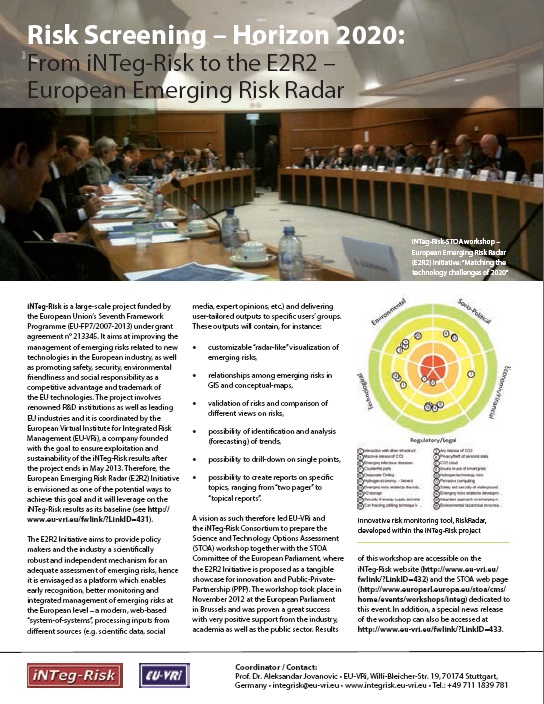 |
|
The Parliament Magazine is the magazine for the European Parliament and it is published every fortnightly to all MEPs, as well as senior officials in the Commission and others EU institutions. In its Issue 336 of April 2, 2013, a one-page feature (found on page 39) is specially dedicated to the iNTeg-Risk project! Click here to read it.
The full copy of this issue can be accessible at http://theparliament.com/digimag/issue366, or downloaded here.
|
|
|
|
|
|
|
01 Feb
2013 |
Paper on iNTeg-Risk ERRA A1 has won a medal! |
 |
A paper on the iNTeg-Risk ERRA A1 -- Wilday, J., et al. (2011). Addressing emerging risks using carbon capture and storage as an example, Process Safety and Environmental Protection, vol. 89, no. 6, pp. 463-471, has won the Frank Lees medal for 2012 which is awarded by the UK Instituation of Chemical Engineers (IChemE)!
 |
The authors of a paper on iNTeg-Risk ERRA A1:
Wilday, J., Paltrinieri, N., Farret, R., Hebrard, J., Breedveld, L. (2011). Addressing emerging risks using carbon capture and storage as an example, Process Safety and Environmental Protection, vol. 89, no. 6, pp. 463-471,
have been awarded the Frank Lees medal for 2012 by the UK Instituation of Chemical Engineers (IChemE). This medal is awarded to the best paper on a safety-related theme in any of the IChemE journals.
The iNTeg-Risk support team hereby extends congratulation to the authors for their achievement.
|
|
|
|
|
|
|
18 Jan
2013 |
SHB/iNTeg-Risk course HSSE: Health, Safety, Security and Environment successfully concluded |
 |
The event was part of the series of courses belonging to the joint effort of iNTeg-Risk project (represented by EU-VRi and other partners) to set a modern, modular and distributed model of education and certification in the area of Risk Engineering and Management, with particular emphasis on the issue of emerging risks. The HSSE course took place in Paris, January 14 - 17, 2013 and was hosted by the iNTeg-Risk partner, INERIS.
| The SHB/iNTeg-Risk course HSSE: Health, Safety, Security and Environment provided the participants with the essentials of HSSE management in Europe by giving an overview of EU regulation in the field of HSSE, explaining the objectives and requirements as well as the state-of-the art in the implementation including constraints and advantages. Special focus was also given to the Integrated Pollution Prevention and Control (IPPC) directive, Industrial Emission Directive (IED) and the directive on prevention of major accidents (Seveso). Click here to see details about the course.
This course took place in Paris from January 14 - 17, 2013 and was hosted by the iNTeg-Risk partner, INERIS. The course was led by Mr. Olivier Salvi (INERIS/EU-VRi) as the main lecturer.
Check out also our calendar of courses to find other topics which may be of interest for you!
|
|
 |
|
|
|
|
|
|
16 Dec
2012 |
Consensus reached on the procedure for iNTeg-Risk’s Emerging Risk Management Framework (ERMF) |
 |
At the 5th meeting of CEN Workshop 67 – "Managing emerging technology-related risks" which took place in December 2012 at CEN-CENELEC Management Centre in Brussels, the participants reached a consensus on the procedure for Emerging Risk Management Framework (ERMF), whereby this framework is developed within and forms the cornerstone of iNTeg-Risk project. Click here to see for more detailed procedure illustrating the process of risk maturation and the ERMF elements.
The 5th meeting of CEN Workshop 67 – "Managing emerging technology-related risks" took place in December 2012 at CEN-CENELEC Management Centre in Brussels, where the participants reached a consensus on the procedure for Emerging Risk Management Framework (ERMF). This framework is developed within and forms the cornerstone of iNTeg-Risk project.
Click here to see for more detailed procedure illustrating the process of risk maturation and the ERMF elements.
This CEN Workshop Agreement is now undergoing the preparation for public comment phase which is scheduled to be launched sometime in February / March 2013. |
|
|
|
|
|
06 Dec
2012 |
STOA Workshop confirmed needs for risk radar across the board |
 |
The Science and Technology Options Assessment (STOA) workshop on European Emerging Risk Radar (E2R2) Initiative, which took place in November 2012 at the European Parliament in Brussels, received very positive support from the industry, academia and public sector. This Initiative aims at providing policy makers and the industry a scientifically robust and independent mechanism for an adequate assessment of emerging risks. Click here to download the special news release dedicated to this workshop!
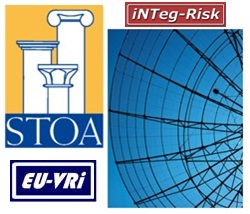 |
EU-VRi and iNTeg-Risk Consortium prepared the Science and Technology Options Assessment (STOA) workshop together with Science and Technology Option Assessment Committee of the European Parliament as an important follow-up to ensure the sustainability of the iNTeg-Risk project results. The proposal of a European Emerging Risk Radar (E2R2) as a tangible showcase for innovation and Public-Private-Partnership which creates added-value for all stakeholders was presented and discussed by the main stakeholders from industry, academia and public sector. All stakeholders agreed that the E2R2 could serve very well as a decision aid tool.
Read more by downloading the special news release dedicated to this workshop. |
|
|
|
|
|
|
07 Nov
2012 |
STOA Workshop on E2R2 Initiative gained very positive support from the industry, academia and public sector |
 |
EU-VRi (www.eu-vri.eu) and iNTeg-Risk Consortium (www.integrisk.eu-vri.eu) prepared this workshop together with Science and Technology Option Assessment Committee of the European Parliament (STOA, http://europarl.europa.eu/stoa). Read more about the results of this workshop by clicking here to access the summary report!
|
STOA Workshop on E2R2
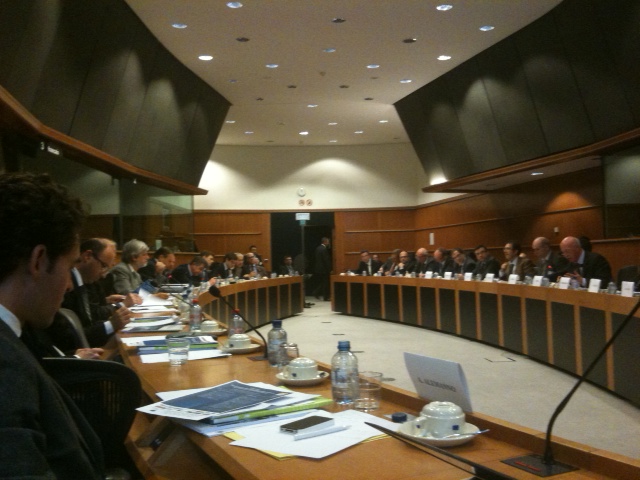
Click on the image to view enlarged version
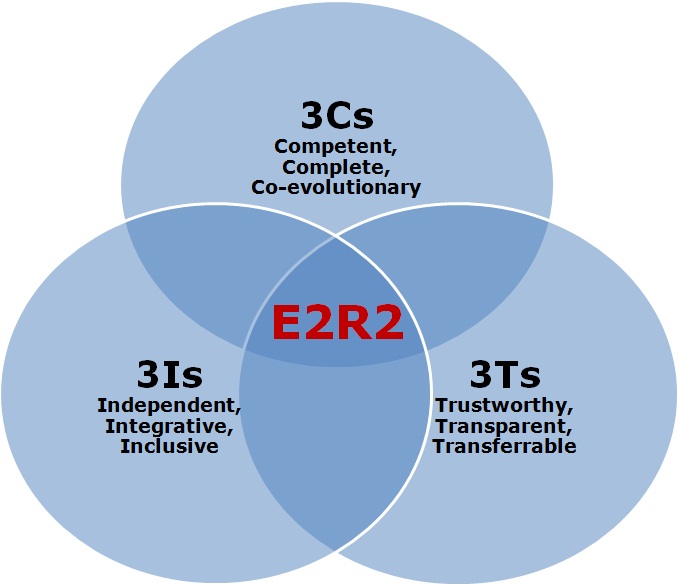
Click on the image to view enlarged version
|
|
Results of STOA Workshop*
|
The STOA workshop on European Emerging Risk Radar (E2R2) Initiative, which took place on November 6, 2012 at the European Parliament in Brussels, successfully concluded with very positive support from the industry, academia and public sector. EU-VRi (www.eu-vri.eu) and the iNTeg-Risk Consortium (www.integrisk.eu-vri.eu) prepared this workshop together with Science and Technology Option Assessment Committee of the European Parliament (STOA, http://europarl.europa.eu/stoa) as an important follow-up to ensure the sustainability of the iNTeg-Risk results. Below are some of the key results from this workshop:
- Notable representatives from the industry, academia and public sector (see short profiles of the speakers and panelists) each presented and/or shared their perspectives regarding their support for the E2R2 Initiative. In summary,
- the Industry is in favor of E2R2 because the initiative could serve as a European reference source for emerging risk information and this will be of huge benefit for the EU industry as well as enhance its competitiveness;
- the Academia is in favor of E2R2 because, in view of the challenges for risk management in a fragmented environment with respect to European risk activities, the initiative poses as a strategic global advantage as well as a way to increase credibility and popularity for Europe; and
- the Public sector is in favor of E2R2 because the initiative promotes efficient use of available resources, enlarge the scope as well as increase the quality of results for governments, in particular, those which are already carrying out similar activities.
- Inspiring discussions across the various sectors during this workshop can be considered as an endorsement of the E2R2 Initiative and that all comments received at this workshop pertaining to this initiative will certainly be taken into account for future developments.
- Drawing from all important suggestions on the E2R2 Initiative made during the presentations and discussions of this workshop, the following “3Cs, 3Ts, 3Is” approach was proposed whereby E2R2 should be:
- Competent, Complete and Co-evolutionary;
- Trustworthy, Transparent and Transferrable; and
- Independent, Integrative and Inclusive.
In view of the above, E2R2 could thus serve very well as a decision aid tool.
* Full summary report comprising results of this workshop can be downloaded on the STOA website at: http://europarl.europa.eu/stoa/cms/home/events/workshops/integ.
|
|
|
|
|
|
|
|
23 Oct
2012 |
Prof. Renn was awarded the "Order of Merit of the Federal Republic of Germany" |
 |
Prof. Ortwin Renn, President of EU-VRi, has received several important awards, in particular the "Order of Merit of the Federal Republic of Germany" (Bundesverdienstkreuz erster Klasse).
 |
Federal President Joachim Gauck awarded Prof. Renn the "Order of Merit of the Federal Republic of Germany" (Bundesverdienstkreuz erster Klasse) upon the suggestion of Minister Annette Schavan. The award recognizes Professor Renn for his "outstanding achievements in the field of science and research" and for his "decades of commitment to strengthening and reputation of research in Germany".
Furthermore, in 2012 Prof. Renn was awarded the "Best Paper Award" of the journal "Risk Analysis" for his articles on "Risk Governance of Oil Platforms in the Barents Sea” authored with Professor Terje Aven. From the International Society for Risk Analysis (SRA). Prof. Renn was also elected as the first non-American to the presidency of the society. This position he will take over in 2013.
Finally, Professor Renn has won the third place in the competition "Best High School Teacher of the Year" organized by the magazine UNICUM, to which some 800 nominations were submitted.
|
|
|
|
|
|
|
24 Sep
2012 |
Course I-R02 PETRO |
 |
The SHB/iNTeg-Risk course I-R02 PETRO: Risk Analysis in Petrochemical Industry was held Sept. 24-28, 2012 in Stuttgart, Germany.
The 5-day course Risk Analysis in Petrochemical Industry has been successfully concluded. The course has taken place between September 24 and 28, 2012 in the Stuttgart Institute of Management and Technology (SIMT) in Stuttgart, Germany.
The course was open for students of the universities and employees of the companies participating in the project, as well as for the external participants.
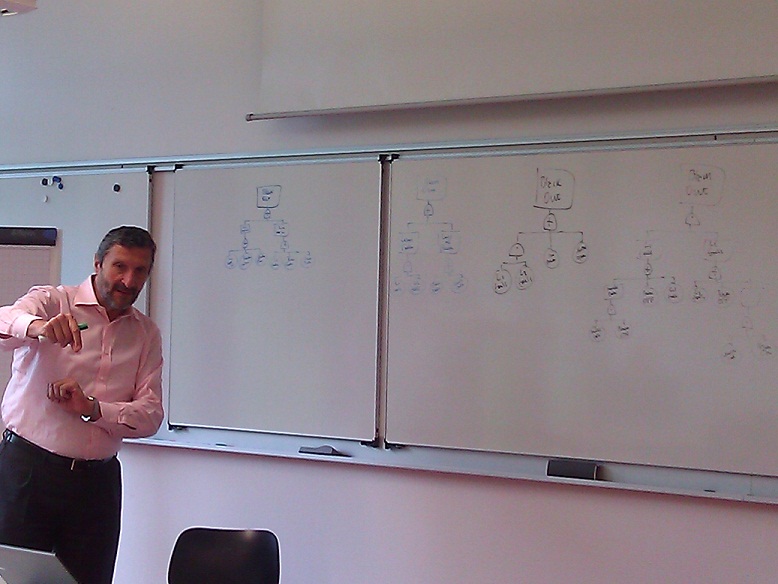
This course presented the current global and regional issues in petrochemical industries. During the course the participants learned about
- risk aspects and the methods for hazard identification applied in petrochemical industries,
- performing probability and consequences analysis and risk assessment, and
- health, safety and environment issues related to petrochemical industries.
Mr. Giovanni Uguccioni from D'Appolonia Spa (Italy) lectured 4 days, elaborating on current global and regional occurrences in the upstream, midstream, downstream and in petrochemical industries. The fifth day was spent by overviewing the course material and the students took an examination testing their acquired knowledge during the course.
|
|
|
|
|
|
|
31 Aug
2012 |
Register for ENISFER & reap the benefits of this network! |
 |
ENISFER is the European Network of Industrial Systems and Facilities for Exploration of Emerging Risks within the EU-VRi organization and tools. This network is in operation since the beginning of 2012, with large industrial companies and renown research organizations among its elite pool of partners. Hence, you are cordially invited to register yourself as an individual (Risk Expert) and/or your Organization/Company and/or Department/Facility and/or other entities. Click here to register for ENISFER now!
|
EU-VRI ENISFER
|
ENISFER is the European Network of Industrial Systems and Facilities for Exploration of Emerging Risks within the EU-VRi organization and tools.
The aim of ENISFER is to have a network of relevant and representative organizations/companies, departments/facilities or persons to continuously innovate and improve management of emerging risks. Therefore, this network will have a structuring effect for all the stakeholders concerned by technology related emerging risks at a regional, national, European or international scale (read more about ENISFER).
In view of the above, you are thus cordially invited to register:
- yourself as an individual (Risk Expert); and/or
- your Organization/Company; and/or
- your Department/Facility; and/or
- other entities.
Follow this link for ENISFER registration*: http://www.eu-vri.eu/fwlink/?LinkID=381
By means of this online registration, all (prospective) ENISFER partners will make available their contact and information to others who are looking for solutions to specific issues related to (emerging) risks. Furthermore, the benefits for joining this network are the ease of:
- finding experts in various areas of (emerging) risk management and engineering;
- finding companies/organizations and their research facilities relevant for your work;
- contacting other ENISFER partners for partnership opportunities.
* Please note that registration to ENISFER is not a membership and at this stage there are no obligations and/or financial contribution foreseen. In addition, the main benefits at this stage are as described above.
|
|
|
|
|
|
|
30 Jul
2012 |
Course on LCA |
 |
The course on Life Cycle Analysis and Assessment was successfully concluded in Stuttgart, Germany.
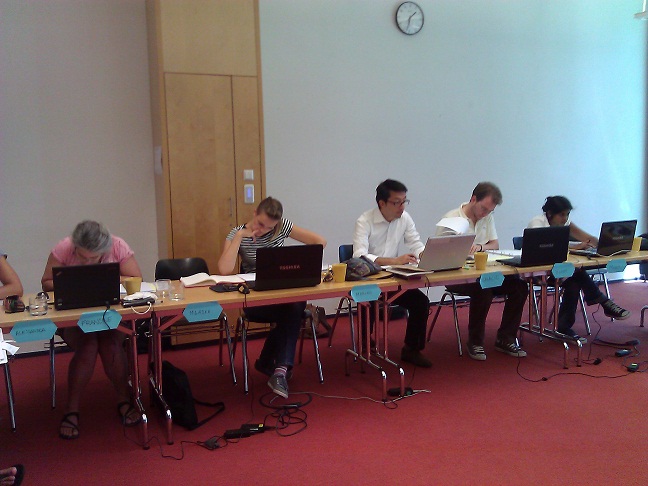
The course was open both for students of the universities participating in the project and for the external participants.
In the course the participants gained a comprehensive overview of the Life Cycle Assessment (LCA), Life Cycle Costing (LCC), International Reference Life Cycle Data System (ILCD) and European Reference Life Cycle Data System (ELCD).
The course is part of the European Master and Certification Program in Risk Engineering and Management, therefore as such, it enabled the participants to earn European ECTS credit points (see http://ec.europa.eu/education/lifelong-learning-policy/ects_en.htm).
|
Read more about the course! |
|
|
|
|
|
17 Jul
2012 |
iNTeg-Risk was presented at World Congress on Risk in Sydney |
 |
The European project iNTeg-Risk was presented at World Congress on Risk (WCR) in Sydney, Australia organized by Society for Risk Analysis (SRA).
|

at
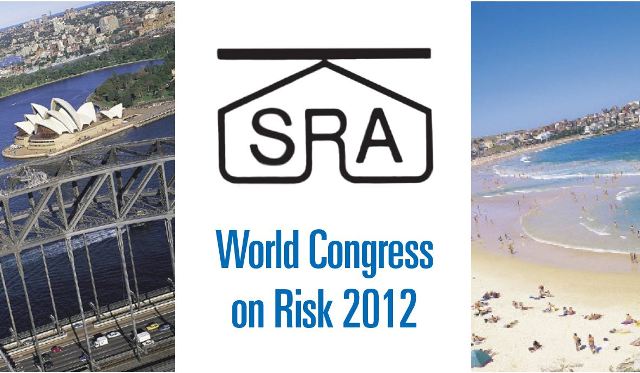
|
The coordinator of iNTeg-Risk project, Aleksandar (Sasa) Jovanovic, gave a presentation on iNTeg-Risk project at WCR in Sydney Australia. The presentation informed participants from all over the world about the main results achieved thus far before the project ends in May 2013. Furthermore, the presentation addresses follow-up initiatives, in particular, the "European Emerging Risk Radar (E2R2)" (click here for more information about E2R2).
Details of the SRA event:
World Congress on Risk (WCR)
Sydney Convention and Exhibition Centre
Sydney, Australia
July 18-20, 2012
The overall theme of the WCR 2012 was Risk and Development in a Changing World, and the three daily sub-themes were:
1. Disasters and Resilience;
2. Global and Emerging Risks; and
3. Risk and Sustainable Development.
Alternatively, visit the SRA WCR webpage at http://sra.org/worldcongress2012 for more information.
|
|
|
|
|
|
|
06 Jun
2012 |
4th iNTeg-Risk Conference 2012 - Presentations available! |
 |
The 4th iNTeg-Risk Conference 2012 which took place in Stuttgart, Germany on May 6-8, 2012 was a great success with very positive on-site feedback received from the participants. The presentations made at the conference are now available for download and further information has been sent to all conference participants via e-mail.
|
4th iNTeg-Risk Conference 2012
"Managing Early Warnings - what and how to look for?"
took place in
Stuttgart, Germany on May 6-8, 2012
in conjunction with
iNTeg-Risk education courses (“European Master of Risk Management and Engineering”) and
OECD workshop “TRANSPORT AND POWER SURVEILLANCE”
and
“China-Europe Risk Forum”
The 4th iNTeg-Risk Conference is an excellent opportunity for project partners to communicate their results to the “outside world” and an opportunity for interested professionals, not participating in the iNTeg-Risk project, to learn about the project and its numerous results (150 deliverables already available) (http://integrisk.eu-vri.eu).
This year, we have had 120 conference participants from over 20 countries, including key note speakers from renowned organisations such as Organisation for Economic Co-operation and Development (OECD), International Risk Governance Council (IRGC), etc. More than 50 presentations were made at the conference with intriguing topics such as "Safe Future: Risk management for Emerging Risks", "Safe Products/Production I: Emerging technologies", etc.
-
Click here to view the detailed program.
-
The presentations made at the conference are now available for download and further information has been sent to all conference participants via e-mail.
For possible queries, please feel free to contact us at integrisk-conference4@eu-vri.eu.
iNTeg-Risk Conference Committee and iNTeg-Risk Project Team |
|
|
|
|
|
|
23 May
2012 |
OECD Workshop on Natech Risk Management, May 23-25, 2012 in Dresden (Germany) |
|
|
|
|
|
|
09 May
2012 |
iNTeg-Risk project brought to life in this NEW video production! |
 |
Since the embarkation of iNTeg-Risk project in 2008, it has shown significant progress with several key achievements. Learn more about the project by clicking here to watch the video (R-Tech).
The iNTeg-Risk project video has been produced to give an overview of the project's basic ideas and objectives, showcase some of the key results achieved thus far as well as present the sustainability of project results after the project ends in May 2013. Click here to watch this video.

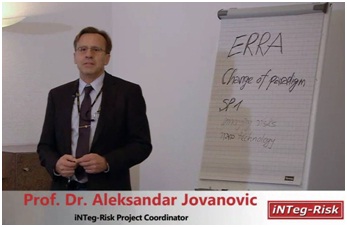
© 2012 Steinbeis Advanced Risk Technologies Group (R-Tech)
|
|
|
|
|
|
07 May
2012 |
Second event of Introduction to Risk Management |
 |
The second instance of the iNTeg-Risk course Introduction to Risk Management took place at the Stuttgart Institute of Management and Technology.
|
The course is part of the series of courses which all belong to joint effort of iNTeg-Risk project (represented by EU-VRi and other partners), University of Stuttgart (ZIRN) and Steinbeis University Berlin (STI Advanced Risk Technologies) to set a modern, modular and distributed model of education and certification in the area of Risk Engineering and Management with particular emphasis on the issue of emerging risks, in particular those related to new technologies.
The event took place on May 2-5, 2012 at the Stuttgart Institute of Management and Technology (SIMT). This specialist course was organized in conjunction with the 4th iNTeg-Risk Conference 2012.
Participants of the course had opportunity to extend their knowledge in the area of industrial safety, starting with different aspects of risks and terminology used in the field, with special focus on major accident prevention and related process safety risk assessment methodology. The participants came from different countries (Spain, Serbia, Germany, China, France, etc.) possessing different profiles (PhD, MSc and BSc students, professionals), thus allowing them to enjoy and profit from a real international environment during the course.
|
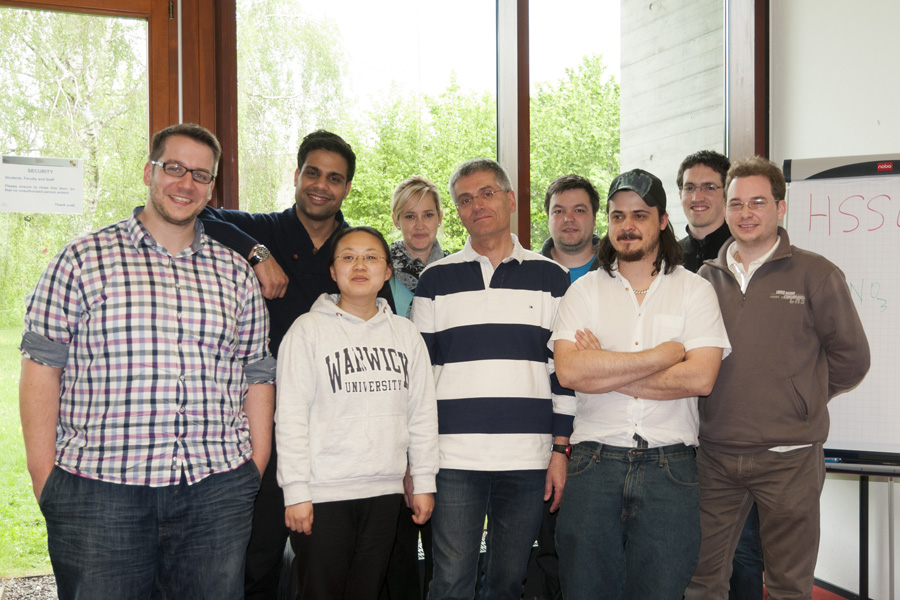
|
|
|
|
|
|
|
27 Apr
2012 |
OECD workshops organized within the iNTeg-Risk project to allow for in-depth treatment of a large number of the WEF threats |
 |
The OECD/IFP study on “Role of space technologies and ICT in the surveillance of global threats” was launched and introduced as a new task within the iNTeg-Risk project, whereby a series of 5 workshops is organized to explore the potential role of space-based technologies and related ICT technologies in coping with 25-35 potential global threats/hazards identified within the OECD FGS project and the WEF.
 |
|
A call for proposals was launched in July 2011 under the task T3.1.9 of the iNTeg-Risk project, whereby the purpose was to explore and promote new topics in the realm of emerging risks within the project; i.e. new Emerging Risk Representative Applications (ERRAs).
Through this call, the iNTeg-Risk project opened itself not only to members of the consortium, but also to external participants, whereby new interesting proposals will eventually become part of Subproject 3 (SP3) which is dedicated to the validation and verification of iNTeg-Risk project results obtained thus far; i.e. the new ERRAs will apply the results coming from Subproject 1 (SP1) and Subproject 2 as well as provide feedback regarding applicability and appropriateness to the project.
Following the call for proposals, joint decisions by EU-VRi (who is leading task T3.1.9) as well as SP1 and SP3 leaders then awarded OECD’s study on “Role of space technologies and ICT in the surveillance of global threats” as one of the most attractive propositions received in this call.
A series of five workshops is thus organized in the context of this new study launched by OECD/ International Futures Programme (IFP), in partnership with public and private actors, with the aim to examine how space technologies and ICT could be useful in addressing potential global threats identified by the OECD Future Global Shocks project and the World Economic Forum.
- First workshop on natural disasters took place on February 27, 2012 in Brussels, whereby the participants and invited experts reviewed three selected natural disasters, namely: earthquakes, tsunamis and geomagnetic storms.
- Second workshop on ocean surveillance took place on March 23, 2012 in London, whereby the participants and invited experts reviewed selected maritime risks.
- Third workshop on transport and power surveillance took place on May 4, 2012 in Stuttgart, whereby the participants and invited experts reviewed two selected topics, namely: threats to air traffic and energy infrastructure.
- Fourth workshop will be on health.
- Fifth workshop will be on space security.
|
|
|
|
|
|
|
18 Apr
2012 |
EC published a guidance document on "How to avoid common errors identified in cost claims" |
 |
To help the beneficiaries of grant support under the 7th Framework Programme (FP7) avoid frequently recurring errors in FP7 Cost Statements (Form Cs), the European Commission (EC) has published a guidance document on "How to avoid common errors identified in cost claims".
 |
A guidance document on "How to avoid common errors identified in cost claims" has been published by the European Commission (EC), whereby it listed 10 of the most frequently recurring errors along with some explanatory notes.
Therefore, the beneficiaries of grant support under the 7th Framework Programme should pay particular attention to the issues set out in this document when preparing their cost claims.
Click here to download the guidance document.
Alternatively, the document can also be found under the Guidance documents section on EC Cordis webpage: http://cordis.europa.eu/fp7/find-doc_en.html
|
|
|
|
|
|
|
16 Apr
2012 |
International Conference on ISO 31000 Risk Management Standard from May 21-22, 2012 in Paris, France |
 |
An outstanding panel of international experts & practitioners was gathered together for the risk management event of the year--The first International Conference on ISO 31000 Risk Management Standard. In partnership with its organisers, we are offering a discount of 10% on all admittance when you register with the code TX324XC! For more info & registration details, visit http://www.G31000conference2012.org.

The first International Conference on ISO 31000 Risk Management Standard took place from May 21-22, 2012 in Paris, France. The conference explored how ISO 31000 standard is changing the global risk management community as well as the latest developments in various sectors.
Key conference topics:
- Understand why the management of risk or ERM should be based on ISO 31000;
- Know how and why ISO 31000 is the global reference for risk management standards;
- See the results from the first global survey on ISO 31000 giving you an insight into how ISO 31000 is presently perceived by different sectors, different countries and the whole risk management community;
- Learn how ISO 31000 can add value in building a solid risk management framework and at each stage of the risk management process;
- Embed ISO 31000 into your organisation’s day-to-day decision making process; and
- Understand how to use practical tools and techniques used in different sectors to facilitate managers’ decision-making processes.
We are offering our support to the event and, in partnership with its organisers, are offering you a discount of 10% on all admittance. You can secure this discount by registering with the code TX324XC.
More information and registration details can be found at http://www.G31000conference2012.org. |
|
|
|
|
|
02 Apr
2012 |
RBI-PETRO was successfully concluded in Rotterdam |
 |
Risk Based Inspection - Petro was part of a course series organized through the joint effort of iNTeg-Risk project, University of Stuttgart and STI Advanced Risk Technologies.
 |
|
The iNTeg-Risk Course II-R4a "RBI-PETRO: Risk Based Inspection - Petro", which is part of the announced series of SHB/iNTeg-Risk courses, took place on March 27-30, 2012 in Rotterdam, the Netherlands.
During the 4-day course, 12 participants from Germany, Romania, China, Italy, Slovakia, the United Kingdom and Serbia had opportunity to learn more about Risk-Based Inspection (RBI) in general, its application in industry using different tools as well as to understand RBI technologies, procedures, and working processes in compliance with the main reference documents.
This series of courses is proudly organized through the joint effort of iNTeg-Risk project, University of Stuttgart (ZIRN) and Steinbeis University Berlin (STI Advanced Risk Technologies) to set a modern, modular and distributed model of education and certification in the area of Risk Engineering and Management with particular emphasis on the issue of emerging risks, especially those related to new technologies.
Furthermore, the course is a part of the European Master and Certification Program in Risk Engineering and Management.
|
|
|
|
|
|
|
23 Feb
2012 |
ESF-STOA Conference 'The Science of Innovation' was held on February 28, 2012 at the European Parliament, Brussels |
 |
The European Science Foundation (ESF) and the Science and Technology Options Assessment (STOA) office jointly organised a conference on 'The Science of Innovation', whereby it contributed to the debate on EU innovation policy at a crucial time by presenting a range of thought-provoking insights.
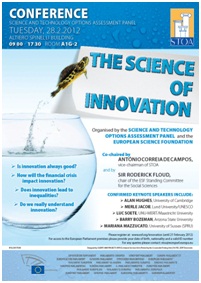 |
|
The Science of Innovation is an important, growing field of research and this ESF-STOA joint conference presented state-of-the-art insights from the cutting edge of 'the science of innovation' on crucial issues for today's policy makers.
Among other questions addressed were: Is innovation always good? How will the financial crisis impact innovation? Does innovation lead to inequalities? Do we really understand innovation?
Keynote speakers included:
- Alan Hughes, Professor of Enterprise Studies at the University of Cambridge, and Director of the Centre for Business Research (CBR)
- Merle Jacob, Professor in Research Policy at Lund University and UNESCO Chair in Research Management and Innovation Systems
- Luc Soete, Director of UNU-MERIT and Professor of International Economic Relations at Maastricht University
- Barry Bozeman, Professor of Public Policy at Arizona State University, Consortium for Science Policy and Outcomes
- Mariana Mazzucato, R.M. Phillips Professor of Science and Technology at the University of Sussex (SPRU)
For more information on the conference including brochure, programme, etc., click here.
|
|
|
|
|
|
|
25 Jan
2012 |
UK Climate Change Risk Assessment: Government Report - First of its kind |
 |
The UK Government published the Climate Change Risk Assessment (CCRA) report on January 25, 2012, the first assessment of its kind for UK and the first in a 5-year cycle. Click here to download this report.
 |
|
The UK Government's CCRA report sets out the main priorities for adaptation in the UK under 5 key themes identified in the CCRA 2012 Evidence Report – Agriculture and Forestry; Business, industries and Services; Health and Wellbeing; Natural Environment and Buildings and Infrastructure – and describes the policy context, as well as the action already in place to tackle some of the risks in each area. In addition, it highlights the constraints of the CCRA analysis and provides advice on how to take account of the uncertainty within the analysis.
For further information on the CCRA including evidence report, summary of the key findings, reports and summaries for each of the eleven sectors, etc., click here.
Media coverage on this report can be accessed below:
|
|
|
|
|
|
|
16 Jan
2012 |
iNTeg-Risk in INERIS "Rapport Scientifique 2010/2011" |
 |
INERIS scientific report devoted attention to the results of iNTeg-Risk project. See more details in INERIS "Rapport Scientifique 2010/2011".
|
|
|
|
|
|
14 Jan
2012 |
Media coverage on World Economic Forum's "Global Risks Report 2012" |
 |
The World Economic Forum's (WEF) "Global Risks Report 2012" which was presented by the Wharton Risk Center, an academic partner of the WEF since 2005, has garnered significant media coverage. Click here to watch the video (WEF).
In the video which is produced by WEF, Erwann Michel-Kerjan, Managing Director of the Wharton Risk Center, examines the main findings of the Global Risks 2012 report and discusses its relevance to the private and public sectors. Click here to watch this video.
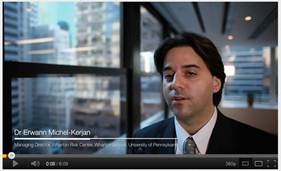
Other relevant media coverage can be accessed below:
- Pfanner, E. (January 11, 2012) Economic Troubles Cited As the Top Risks in 2012. The New York Times.
- Video: Howard Kunreuther, Co-Director of the Wharton Risk Center, addresses globalization and the results of interconnectedness in this interview for CBC Toronto. Click here to watch this video.

- Handley, M. (January 17, 2012) Top 5 Global Risks for 2012. U.S. News and World Reports.
- Video: Erwann Michel-Kerjan discusses some of the report’s findings with Erik Schatzker in Bloomberg Television's "Inside Track" on January 20, 2012. Click here to watch this video.
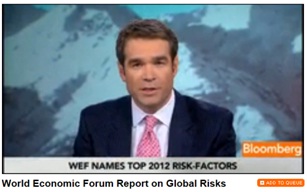
- Lu, K., & Michel-Kerjan, E. (January 21, 2012) Is Income Disparity Slowly Fueling the Next Global Crisis?. The Wall Street Journal (Asia).
|
|
|
|
|
|
14 Jan
2012 |
Global Risks Report 2012 - Wharton partnership with the World Economic Forum |
 |
The Wharton Risk Center, an academic partner of the World Economic Forum (WEF) since 2005, is pleased to present the WEF’s Global Risks Report 2012, Seventh Edition. Click here to download this report.
|
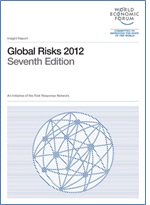
|
The WEF’s Global Risks Report 2012 has identified chronic fiscal imbalances and severe income disparity as the most prevalent risks over the next 10 years. These risks in tandem threaten global growth as they are drivers of nationalism, populism and protectionism at a time when the world remains vulnerable to systemic financial shocks, as well as possible food and water crises. These are the findings of a survey of 469 experts and industry leaders, indicating a shift of concern from environmental risks to socioeconomic risks, compared to a year ago.
Read more about the Global Risks Report here.
* For nearly three decades, the Wharton Risk Center has been at the forefront of basic and applied research in promoting effective corporate and public policies for low-probability events with potentially catastrophic consequences. Listed below are some of the media coverage on the Risk Center's research:
|
|
|
|
|
|
|
30 Dec
2011 |
Risk - we care! - New brochure of EU-VRi and Steinbeis Advanced Risk Technologies |
 |
EU-VRi and Steinbeis Advanced Risk Technologies have published a new brochure "Risk - we care®!" containing interesting information, events and projects about the past 10 years of R-Tech and the past 5 years of EU-VRi.
Link for download
 |
EU-VRi and Steinbeis Advanced Risk Technologies have published a new brochure "Risk - we care®!" containing interesting information, events and projects about the past 10 years of R-Tech and the past 5 years of EU-VRi.
For downloading the brochure please use the following link: http://www.eu-vri.eu/filehandler.ashx?file=9243
|
|
|
|
|
|
|
19 Dec
2011 |
CFS Audit closed |
 |
Audit reports for projects:
*NANODEVICE - Novel Concepts, Methods, and Technologies for the Production of Portable, Easy-to-Use Devices for the Measurement and Analysis of Airborne Engineered Nanoparticles in Workplace Air
* Alfa-Bird - Alternative Fuels and Biofuels for Aircraft Development
* iNTeg-Risk - Early Recognition, Monitoring and Integrated Management of Emerging, New Technology related Risks)
formally accepted and approved by the European Commission (with less than 0.05 % adjustment needed!).

|
Audit reports for projects
- NANODEVICE - Novel Concepts, Methods, and Technologies for the Production of Portable, Easy-to-Use Devices for the Measurement and Analysis of Airborne Engineered Nanoparticles in Workplace Air
- Alfa-Bird - Alternative Fuels and Biofuels for Aircraft Development
- iNTeg-Risk - Early Recognition, Monitoring and Integrated Management of Emerging, New Technology related Risks)
formally accepted and approved by the European Commission (with less than 0.05 % adjustment needed!) |
|
|
|
|
|
|
17 Dec
2011 |
The course Introduction to Risk Management took place in Stuttgart |
 |
The course opened a series of courses to set a modern, modular and distributed model of education and certification in the area of Risk Engineering and Management.
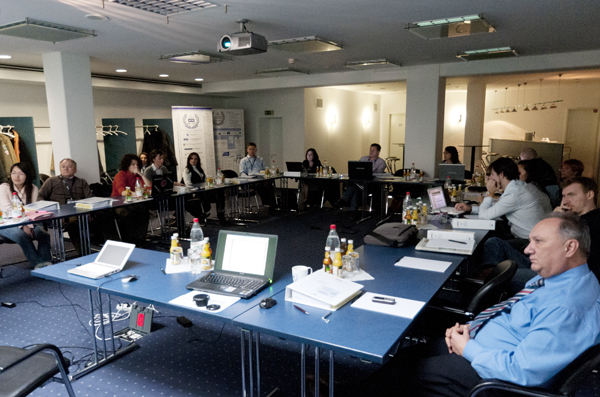 |
|
The course Introduction to Risk Management has taken place between December 12 and 16, 2011 in Stuttgart. It opened a series of courses which all belong to joint effort of iNTeg-Risk project (represented by EU-VRi and other partners), University of Stuttgart (ZIRN) and Steinbeis University Berlin (STI Advanced Risk Technologies) to set a modern, modular and distributed model of education and certification in the area of Risk Engineering and Management with particular emphasis on the issue of emerging risks, in particular those related to new technologies.
The course is also a part of SHB's European Master and Certification Program in Risk Engineering and Management.
During five days of the course, 20 participants from Germany, Italy, France, Greece, Serbia and United Arab Emirates had opportunity to learn and extended their knowledge on the main topics of risks related to the general use of the chemicals by a modern society and related industrial sectors (hazards, related risks, and due legislative safety measures considering accidental and chronic risks within life cycle of hazardous materials, major accidents prevention and
related process safety risk assessment methodology).
|
|
|
|
|
|
|
30 Nov
2011 |
Involvement of the EU-VRi/iNTeg-Risk partners into the first global survey of ISO 31000–Risk Management Principle and Guidelines |
 |
Following the approved liaison between ISO 31000 and EU-VRi/iNTeg-Risk (see news entry), a discussion between the iNTeg-Risk Project Coordinator and the CEO of EU-VRi, A. Jovanovic, and the Moderator of the LinkedIn ISO 31000 Risk Management Standard Group, A. Dali, took place. One of the main results, so far, would be the involvement of the EU-VRi/iNTeg-Risk partners into the first global survey of ISO 31000–Risk Management Principle and Guidelines set to kick off on the 17th of October this year.
Following the approved liaison between ISO 31000 and EU-VRi/iNTeg-Risk (see news entry), a discussion between the iNTeg-Risk Project Coordinator and the CEO of EU-VRi, A. Jovanovic, and the Moderator of the LinkedIn ISO 31000 Risk Management Standard Group, A. Dali, took place.
One of the main results, so far, would be the involvement of the EU-VRi/iNTeg-Risk partners into the first global survey of ISO 31000–Risk Management Principle and Guidelines set to kick off on the 17th of October this year. The aim of the survey is to gauge how ISO 31000 is perceived by risk practitioners across all sectors and to provide input for the preparation of the ISO 31004 guide, due out in 2013.
Members of more than 70 risk management associations around the world are invited to participate in the study which is being run through an initiative by the LinkedIn discussion group on ISO 31000. Issued in November 2009, ISO 31000 provides principles and generic guidelines on risk management. It can be used by any public, private or community enterprise, association, group or individual and is not specific to any industry or sector. "This is the first time the global risk management community active across all fields, sectors, industries and services is being invited to participate in an international survey on ISO 31000. It is a great opportunity to share your thoughts and concerns about the ISO standard on risk management" said Alex Dali.
The survey will run from
Oct. 17, 2011 to Nov. 30, 2011. (extended deadline)
You will be encouraged to participate through EU-VRi/iNTeg-Risk sites or the LinkedIn group. You can join the discussion forum preparing the survey at: http://www.linkedin.com/groups?mostPopular=&gid=1834592.
We encourage your participation and will gladly support it. |
|
|
|
|
|
22 Nov
2011 |
US EPA Report "Guidance to Facilitate Decisions for Sustainable Nanotechnology" |
 |
The United States Environmental Protection Agency (US EPA) recently published a report on "Guidance to Facilitate Decisions for Sustainable Nanotechnology". Click here to read this report.
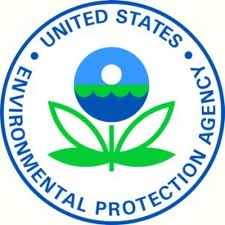 |
This US EPA report on "Guidance to Facilitate Decisions for Sustainable Nanotechnology" provides further insight into the current practices of performing environmental, health, economic and social assessment of nanotechnological applications.
This report was developed to provide a broad guidance for assessing the sustainability of nanoproducts and is intended to lay the groundwork for developing a decision-support framework through continual updates as research in this area progresses. Furthermore, it will aid stakeholders when navigating the various choices that must be made to foster the development of sustainable nanotechnology.
|
|
|
|
|
|
|
15 Nov
2011 |
Society for Risk Analysis - World Congress on Risk 2012 |
 |
The Society for Risk Analysis (SRA) will be holding the following event in Sydney, Australia from July 18-20, 2012: World Congress on Risk (WCR) - Risk and Development in a Changing World.
 |
Details of the SRA event:
World Congress on Risk (WCR)
Sydney Convention and Exhibition Centre
Sydney, Australia
July 18-20, 2012
The overall theme of the WCR 2012 is Risk and Development in a Changing World, and the three daily sub-themes are:
1. Disasters and Resilience;
2. Global and Emerging Risks; and
3. Risk and Sustainable Development.
Click here to download the Call for Proposals which includes guidelines and selection criteria as well as information about travel stipends.
Alternatively, visit the SRA WCR webpage at http://sra.org/worldcongress2012 for more information.
|
|
|
|
|
|
|
15 Nov
2011 |
IRGC Concept Note "Improving the Management of Emerging Risks" |
 |
IRGC is pleased to announce the publication of their latest Concept Note "Improving the Management of Emerging Risks: Risk from new technologies, system interactions, and unforeseen or changing circumstances". Click here to download this publication.
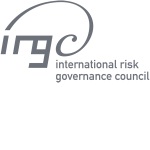 |
This Concept Note is an effort to set forth ideas for more proactive management of emerging risks, in particular in industry. It is intended for senior management in private sector organisations, although the ideas also apply in the public sector, and particularly, in government agencies with responsibility for establishing and enforcing risk regulation. The aim is to stimulate discussion at the conceptual and policy level on how management of emerging risks can be improved, and on how further research in a variety of disciplines might contribute to such improvement.
|
|
|
|
|
|
|
01 Nov
2011 |
DEADLINE EXTENDED for the Global ISO 31000 Survey |
 |
The first global survey of ISO 31000 – Risk Management Principle and Guidelines has started on October 17, 2011 and will run until November 30, 2011 (extended deadline). The purpose of the survey is to see how ISO 31000 is perceived and is being used within organisations by management and risk management practitioners. Follow this link to participate in this survey.
 |
This global survey is organised by the LinkedIn discussion forum on ISO 31000, in close collaboration with over 100 risk management associations and other LinkedIn groups.
Management and risk management practitioners are strongly encouraged to participate in this survey and share their thoughts as well as concerns about the ISO standard before the planned publication of ISO 31004: Implementation Guide for ISO 31000:2009 which is scheduled for 2013.
The results of this survey will be published on various websites without identifying those who responded.
|
|
|
|
|
|
|
18 Oct
2011 |
EUROPEAN COMMISSION - PRESS RELEASE - What is a nanomaterial? |
 |
What is a nanomaterial? European Commission brings a common definition of a nanomaterial, the definition will be now applied in all EU-VRi/R-tech projects dealing with nanotechnology (iNTeg-Risk, MUST, PARTICOAT, Nanodevice…)
 |
EUROPEAN COMMISSION - PRESS RELEASE
What is a "nanomaterial"? European Commission breaks new ground with a common definition
Brussels, 18 October 2011 – "Nanomaterials" are materials whose main constituents have a dimension of between 1 and 100 billionth of a metre, according to a recommendation adopted by the European Commission today. The announcement marks an important step towards greater protection for citizens, clearly defining which materials need special treatment in specific legislation.
European Environment Commissioner Janez Potočnik said: "I am happy to say that the EU is the first to come forward with a cross-cutting designation of nanomaterials to be used for all regulatory purposes. We have come up with a solid definition based on scientific input and a broad consultation. Industry needs a clear coherent regulatory framework in this important economic sector, and consumers deserve accurate information about these substances. It is an important step towards addressing any possible risks for the environment and human health, while ensuring that this new technology can live up to its potential."
Nanomaterials are already being used in hundreds of applications and consumer products ranging from toothpaste to batteries, paints and clothing. Developing these innovative substances is an important driver for European competitiveness, and they have significant potential for progress in areas like medicine, environmental protection and energy efficiency. But as uncertainties remain about the risks they pose, a clear definition is needed to ensure that the appropriate chemical safety rules apply. The definition will help all stakeholders including industry associations, as it brings coherence to the variety of definitions that are currently in use in different sectors. The definition will be reviewed in 2014 in the light of technical and scientific progress.
The recommendation also delivers on a commitment made in 2009 to the European Parliament to issue a single definition that is broadly applicable to all EU legislation concerned by nanomaterials.
The definition adopted today is based on an approach considering the size of the constituent particles of a material, rather than hazard or risk. The wording describes a nanomaterial as "a natural, incidental or manufactured material containing particles, in an unbound state or as an aggregate or as an agglomerate and where, for 50% or more of the particles in the number size distribution, one or more external dimensions is in the size range 1 nm – 100 nm."
The definition is based on scientific advice from the Scientific Committee on Emerging and Newly Identified Health Risks (SCENIHR) and the Joint Research Centre (JRC). A draft version of the definition was subject to a public consultation.
Background
Nanomaterials are currently governed by a variety of legislative instruments at EU and national level. However, definitions have been developed on a case-by-case basis and vary across sectors, creating unnecessary burdens for industry and hampering public debate about risks and benefits of these substances. This recommendation gives EU legislators a legal reference for nanomaterials, when adopting new or implementing existing legislation.
The experience of the first registration deadline (30 November 2010) under REACH, the EU's overarching chemicals policy, showed that companies needed more clarity about their obligations with regard to nanomaterials. REACH has a key role to play in generating information about the properties of nanomaterials as chemical substances. With the adopted definition it will be easier for companies to assess their registration dossiers and determine exactly when they should consider their products as nanomaterials.
Further information:
http://ec.europa.eu/environment/chemicals/nanotech/index.htm
MEMO/11/704
|
|
|
|
|
|
|
23 Sep
2011 |
ISO confirmed the liaison between ISO/PC 262 and EU-VRi |
 |
We are proud to inform that the International Organization for Standardization (ISO) has officially confirmed the liaison between ISO/PC 262 (Project Committee: Risk Management) and EU-VRi.
TC 262 - Project committee: Risk management
|
The International Organization for Standardization (ISO) has officially confirmed the liaison between ISO/PC 262 (Project Committee: Risk Management) and EU-VRi. The ISO/PC 262 members, comprising 31 participating countries and 6 observing countries, have kindly accepted the liaison application of EU-VRi.
EU-VRi and its members are looking forward to a fruitful collaboration and exchange on standardization activities in the field of ISO 31000 family of standards, and ISO 31004 in particular.
Find out more about ISO/PC 262 by following this link. |
|
|
|
|
|
|
05 Sep
2011 |
Collaboration with IRIS – joint case study to be discussed at the IRIS Summer Academy |
 |
Project Coordinators of IRIS and iNTeg-Risk project are discussing next steps concerning the collaboration of these two large FP7 projects at the IRIS Summer Academy on September 5-6, 2011 at Zell am See, Austria.
 |
Helmut Wenzel and Aleksandar Jovanovic, Project Coordinators of IRIS and iNTeg-Risk project, are discussing next steps concerning the collaboration of these two large FP7 projects at the IRIS Summer Academy on September 5-6, 2011 at Zell am See, Austria. One of the collaborations agreed between the two projects is a joint case study using latest results from both projects. For more information on IRIS project, see http://www.vce.at/iris/.
|
|
|
|
|
|
|
05 Sep
2011 |
Liaisoning of ISO TC262 and iNTeg-Risk project |
 |
iNTeg-Risk Project Coordinator Aleksandar Jovanovic will meet ISO TC262 on September 12-16, 2011 in London to discuss synergies between the iNTeg-Risk CWA and the ISO/AWI 31004 which is about the implementation of ISO 31000.
UPDATE: Today TC262 accepted the liaisoning proposal from EU-VRi/iNTeg-Risk, full participation awaiting the end of the formal procedure which is still in course.
 |
iNTeg-Risk project will have the opportunity to participate in the next meeting of ISO TC262 which is dedicated to Risk Management on September 12-16, 2011 in London, UK. The objective is to discuss synergies between the iNTeg-Risk CEN workshop agreement, which are being developed in Subproject 4, and the ISO/AWI 31004 which is about the implementation of ISO 31000. See more information on ISO TC262 under http://www.iso.org/iso/standards_development/technical_committees/list_of_iso_technical_committees/iso_technical_committee.htm?commid=629121.
UPDATE: Today TC262 accepted the liaisoning proposal from EU-VRi/iNTeg-Risk, full participation awaiting the end of the formal procedure which is still in course.
|
|
|
|
|
|
|
01 Sep
2011 |
New CEN Workshop announced at CEN websites |
 |
The CEN workshop "General Framework and Guidelines for Early Recognition, Monitoring and Integrated Management of Emerging New Technology Related Risks (iNTeg-Risk)" (WS 67) has been announced on CEN websites (see CEN website here).
 |
We are pleased to inform you that the CEN workshop "General Framework and Guidelines for Early Recognition, Monitoring and Integrated Management of Emerging New Technology Related Risks (iNTeg-Risk)" (WS 67) has been announced on CEN websites (see CEN website here).
We would like to thank all persons involved in WP4.9, which is dedicated to the development of CWAs in iNTeg-Risk project, for their valuable contributions and we are looking forward to creating interesting and useful pre-standadization documents under the umbrella of this workshop by taking into account the results of iNTeg-Risk project.
The draft Business plan
The draft Business Plan for the new CEN Workshop is available via the link above.
Kick-Off Meeting
The Kick-Off Meeting of the workshop took place in Brussels on Friday, 4 November 2011 at CEN-CENELEC Meeting Centre, Avenue Marnix 17, 1000 Brussels (see Project Calendar).
Secretariat
DIN has volunteered to provide the secretariat.
Chairmanship
A Chairman and two Vice-Chairmen have been nominated for the Workshop (CVs are as well available on CEN website). Their appointment will be confirmed at the Kick-Off Meeting.
For any question regarding the workshop, do not hesitate to contact integrisk@eu-vri.eu. |
|
|
|
|
|
|
20 Jul
2011 |
European Commission launches the call for proposals in the thematic priority NMP of FP7 |
 |
EC has launched the current call for proposals under the 2011 and 2012 Cooperation work programme of Seventh Framework Programme (FP7) for Research, Technological Development and Demonstration Activities (2007 to 2013) and amongst them is the Work Programme 2012 - Theme 4: Nanosciences, Nanotechnologies, Materials and new Production Technologies (NMP). Download the relevant published paper here.
 |
With the unveiling of multiple calls for proposals for all FP7 programmes, this new call invites applicants to present their interesting proposals.
All current call publications as well as related information can be found here. |
|
|
|
|
|
|
14 Jul
2011 |
Extensive media coverage on the report of OECD's "Future Global Shocks" (FGS) project |
 |
Extensive coverage in the international press was given to the report of OECD's FGS project which has come to a fruitful conclusion as the organisation presented the project findings on June 27, 2011.
Click here to watch the news broadcast (Reuters).
 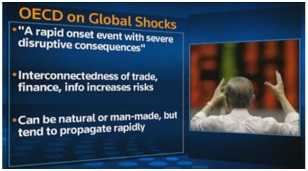
Source: Reuters news broadcast
|
List of FGS media coverage
- Dolan, M., & Pitchford, R. (2011, June 29) Analysis: Serial shocks forcing world to "think long". Thomson Reuters.
- OECD says globalisation increases risks. (2011, June 27) Agence France Presse/ Yahoo! Inc.
- Yang, L. (2011, June 27) OECD predicts more frequent shocks to world economy. Xinhua News Agency.
- Para la OCDE, la economía mundial sufrirá crisis más frecuentes y graves. (2011, June 27) (iEco) Clarín.com.
- Recomienda OCDE anticiparse a mayores efectos de impactos globales. (2011, June 27) Notimex/ SDPnoticias.com.
- Les 5 menaces qui planent sur l’économie mondiale. (2011, June 27) Trends.be.
- L'OCDE pointe les menaces qui planent sur l'économie mondiale. (2011, June 27) LaTribune.fr.
- O'Grady, S. (2011, June 28) World economy set to face more frequent shocks. independent.co.uk.
- Foucart, F. (2011, July 1) L’OCDE met en garde contre les effets d’une éruption solaire sur l’économie. Le Monde.
- Aldrick, P. (2011, June 28) Risk of global 'shocks' has increased, says OECD. Telegraph Media Group Limited.
- Gefahr globaler Schocks wird zunehmen. (2011, June 28) Lëtzebuerger Journal S.A.
- Jackson, G. (2011, June 27) Crises likely to get more frequent, OECD says. Fundweb/ Centaur Media Plc.
- "Le monde va connaître des chocs plus fréquents !", selon l'OCDE. (2011, June 27) Boursier.com.
- Mitchell, R. (2011, June 28) OECD Says Preparation Needed Ahead of Coming Shocks to Global Economy. Daily Report for Executives.
|
|
|
|
|
|
|
14 Jul
2011 |
EU-VRi, together with University of Stuttgart (ZIRN) and Steinbeis R-Tech, made exemplary contribution to the OECD project “Future Global Shocks” (FGS) |
 |
OECD's FGS project came to a fruitful conclusion whereby EU-VRi, together with University of Stuttgart (ZIRN) and Steinbeis R-Tech, contributed notably to the project with their work on one of the selected case studies (Social Unrest). Click to download FGS project report: 1. Executive Summary; or 2. Full report (preliminary version).
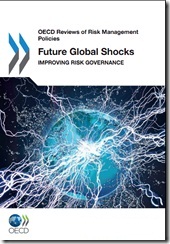 |
|
OECD proudly presented the findings of its two-year "Future Global Shocks" (FGS) project on June 27, 2011.
While discussing a wide range of future shock scenarios, much of the project's focus was set on five highly disruptive future shock events, namely:
- Systemic Financial Risk;
- Pandemics;
- Cyber Risks;
- Geomagnetic Storms; and
- Social Unrest.
Steinbeis will also be publishing the reports of these five case studies. |
|
|
|
|
|
|
21 Jun
2011 |
Horizon 2020 - the Framework Programme for Research and Innovation |
 |
Máire Geoghegan-Quinn, European Commissioner for Research, Innovation and Science, has announced the new name of the future EU funding programme for research and innovation: "Horizon 2020 - the Framework Programme for Research and Innovation", which will enter into force on 1 January 2014, after the end of FP7 on 31 Dec 2013. Click here to read this statement.
 |
|
The new name, "Horizon 2020 - the Framework Programme for Research and Innovation", is an important symbol of a new departure and a new adventure whereby the cutting-edge, integrated funding system will cover all research and innovation funding currently provided through the Framework Programme for Research and Technical Development, the Competitiveness and Innovation Framework Programme (CIP) as well as the European Institute of Innovation and Technology (EIT). With this system, redundant red tape will be eliminated and access to the programs as well as participation will be made easier and simpler.
Moreover, in an effort to further boost excellence as well as ensure that good ideas reach the market and generate sustainable economic growth and new jobs, the different types of the aforementioned funding will be brought together in a coherent and flexible manner so as to support researchers and innovators in Europe. These research and innovation funding will focus clearly on addressing global challenges. |
|
|
|
|
|
|
15 Jun
2011 |
3rd iNTeg-Risk Conference 2011 - Presentations available! |
 |
The 3rd iNTeg-Risk Conference 2011 took place in Stuttgart, Germany on June 6-10, 2011, in conjunction with the SRA-Europe 2011 Annual Meeting. The presentations are available for download. Further information have been sent to all participants via e-mail.
 |
Early Recognition, Monitoring and Integrated Management
of Emerging, New Technology Related, Risks
www.integrisk.eu-vri.eu |
3rd iNTeg-Risk Conference 2011
"Risk vs. Risk: Managing Emerging Risk-Benefit Tradeoffs in Complex Systems"
took place in
Stuttgart, Germany on June 6-10, 2011
in conjunction with
SRA-Europe 2011 Annual Meeting (June 5-8, 2011) www.sraeurope.org,
iNTeg-Risk workshops/courses and iNTeg-Risk ES Seminar

|
Venue:
Haus der Wirtschaft
Willi-Bleicher-Strasse 19
70174 Stuttgart, Germany
http://www.hausderwirtschaft.de
(25 mins by metro to the airport,
10 mins walk to the main railway station) |
The conference was an excellent opportunity for project partners to communicate their results to the “outside world” and an opportunity for interested professionals, not participating in the iNTeg-Risk project, to learn about the project (www.integrisk.eu-vri.eu, budget approx. 20 million €, 80+ companies involved).
The detailed program can be seen following the link.
The presentations are available for download. Further information have been sent to all participants via e-mail.
|
|
|
|
|
|
24 Mar
2011 |
iNTeg-Risk in NHESS's published paper "Industrial accidents triggered by natural hazards: an emerging risk issue" |
 |
A recent paper published by Natural Hazards and Earth System Sciences (NHESS) describes some of the Natech work in the iNTeg-Risk project, whereby these dedicated efforts are well-commended for allowing the framing of challenges posed by risk management of Natech scenarios. Read the full published paper here.
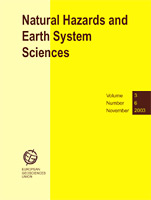 |
|
NHESS is an international and interdisciplinary journal for the publication of original research concerning natural hazards and it has recently published a paper titled "Industrial accidents triggered by natural hazards: an emerging risk issue", which describes some of the Natech work in the iNTeg-Risk project. |
|
|
|
|
|
|
13 Mar
2011 |
Japanese multiple catastrophe |
 |
EU-VRi President, Prof. O. Renn, speaks at German television about the Japanese multiple catastrophe (earthquake, tsunami, nuclear accidents). Need to understand the concept of societal/political decision about "the acceptable remaining risk", relationship between alternatives (multiple risks and risk-risk tradeoffs!), inclusion of time into the considerations... Just as the disaster itself, the debate show that the topics dealt/tackled by the EU-VRi and its members (Steinbeis R-Tech, INERIS, Univ. of Stuttgart ZIRN, ... ) , and in particular iNTeg-Risk project (e.g. NaTech – Nature-technology risks) and this year's iNTeg-Risk Conference (Multiple risks, risk-risk-tradeoffs...) timely and important are.
The whole broadcast is to be seen using the link.
 |

|
EU-VRi President, Prof. O. Renn, speaks at German television about the Japanese multiple catastrophe (earthquake, tsunami, nuclear accidents). Need to understand the concept of societal/political decision about "the acceptable remaining risk", relationship between alternatives (multiple risks and risk-risk tradeoffs!), inclusion of time into the considerations... Just as the disaster itself, the debate show that the topics dealt/tackled by the EU-VRi and its members (Steinbeis R-Tech, INERIS, Univ. of Stuttgart ZIRN, ... ) , and in particular iNTeg-Risk project (e.g. NaTech – Nature-technology risks) and this year's iNTeg-Risk Conference (Multiple risks, risk-risk-tradeoffs...) timely and important are.
The whole broadcast is to be seen using the
link.
|
|
|
|
|
|
|
26 Jan
2011 |
IRGC has published the report ‘The Emergence of Risks: Contributing Factors’ |
 |
The publication of this report marks the conclusion of the first phase of IRGC’s ongoing project on emerging risks. With this report, IRGC aims to raise awareness among professionals about the fact that risks emerge from a common ‘fertile ground’ cultivated by twelve generic factors which are described and illustrated in detail within the report. Click here to download this report.
IRGC and Emerging Risks
The International Risk Governance Council ( IRGC) is an independent foundation, which aims to improve the understanding and management of global risks that impact on human health and safety, the environment, the economy and society at large.
The project on emerging risks is part of IRGC’s work on core concepts of risk governance, and follows on from its work on risk governance deficits. IRGC defines as “emerging” a risk that is new, or a familiar risk in a new or unfamiliar context or under new context conditions (re-emerging). Emerging risks are issues that are perceived to be potentially significant but which may not be fully understood and assessed, thus not allowing risk management options to be developed with confidence.
 |
The Emerging Risks Report
The publication of this report marks the conclusion of the first phase of IRGC’s ongoing project on emerging risks. The objective of this first phase was to focus on the origins of emerging risks. With this report, IRGC aims to raise awareness among professionals about the fact that risks emerge from a common ‘fertile ground’ that is cultivated by twelve generic factors. The report describes and illustrates these twelve factors, which have the potential to amplify or attenuate the likelihood of a new risk emerging or the severity of its consequences. Some of these factors may provide ripe targets for risk management measures.
Phase 2 of the emerging risks project, currently underway, will explore the major obstacles that risk practitioners must overcome in order to improve their own capabilities for understanding, anticipating and responding to emerging risks. IRGC is working towards developing practical guidance for both the public and private sectors on how such obstacles can be overcome.
For downloading the report please use the following link: http://irgc.org/IMG/pdf/irgc_ER_final_07jan_web.pdf
|
|
|
|
|
|
|
14 Jan
2011 |
Job Vacancy |
 |
Steinbeis Advanced Risk Technologies and EU-VRi are looking for skilled and motivated professionals and MSc/PhD students ("internees") for EU and industrial projects in the area of Risk Engineering and Management.
Steinbeis Advanced Risk Technologies
(www.risk-technologies.eu)
Stuttgart, Germany
and

European Virtual Institute for Integrated Risk Management
(www.eu-vri.eu)
Stuttgart, Germany

JOB VACANCY
Steinbeis Advanced Risk Technologies and EU-VRi are looking for skilled and motivated professionals for EU and industrial projects in the area of
Risk Engineering and Management
dealing with:
- integrated risk management, see project iNTeg-Risk (www.integrisk.eu-vri.eu)
- impacts of new bio-fuels in industry, see project Alfa-Bird (www.alfa-bird.eu-vri.eu)
- life cycle analysis and use of nanotechnologies, see projects MUST (www.must.risk-technologies.com), PARTICOAT (www.particoat.eu), and others
- risk management in industry (RBI, RCM, HAZOP, HSE...) and
- applications of the EU directives like SEVESO, REACH, Solvency, INSPIRE...
The applicants' profiles to be considered are:
- Mechanical, Electrical, Process, Materials or Chemical Engineers, with IT-skills and/or interest in the area of risk management
- Software Engineers (IT), with engineering skills and/or interest in the area of risk management
- Risk and sustainability professionals
Currently open are the following positions:
1 or more researchers
for projects MUST, PARTICOAT and similar projects
1 or more researchers
for projects ALFA-BIRD, iNTeg-Risk and the industrial projects
2 or more fellows/internees
for the development of data/knowledge bases, key performance indicators and GIS systems
(NOTE: the fellowship can be combined with Master/PhD study at Steinbeis University!)
The candidates should:
- have an academic/engineering degree (researchers) or be working towards it (fellows)
- have basic or advanced knowledge of web and other IT technologies
- posses analytical skills and be motivated to learn and cope with new research issues
- be fluent in English (certification on TOEFL, GRE or other comparable test is an advantage), knowledge of German and/or other languages can be of benefit
Successful candidates will be offered:
- competitive, result-dependent remuneration
- support for further education/training and other fringe benefits
The work will be performed in the Steinbeis/EU-VRi offices in Germany and may include frequent business travelling or on-site assignments in industrial plants.
Interested candidates should apply by e-mail to:
info@risk-technologies.com
June 2010 |
|
|
|
|
|
17 Dec
2010 |
EU-VRi Official Partner of the Healthy Workplaces Campaign |
 |
EU-VRi has received the certificate as an Official Partner of the Healthy Workplaces Campaign 2010-2011, which is co-ordinated by the European Agency for Safety and Health at Work and its partners in the 27 EU Member States, supports a wide range of activities at the national and European level that promote safe maintenance. It will highlight the importance of maintenance (of plants, equipment, machines and workplaces) to eliminate workplace hazards, and to provide safer and healthier working conditions in workplaces throughout Europe. It is backed by the EU Presidencies of Spain and Belgium in 2010 and of Hungary and Poland in 2011, by the European Parliament and the European Commission, and by the European Social Partners.

|
EU-VRi has received the certificate as an Official Partner of the Healthy Workplaces Campaign 2010-2011, which is co-ordinated by the European Agency for Safety and Health at Work and its partners in the 27 EU Member States, supports a wide range of activities at the national and European level that promote safe maintenance. It will highlight the importance of maintenance (of plants, equipment, machines and workplaces) to eliminate workplace hazards, and to provide safer and healthier working conditions in workplaces throughout Europe. It is backed by the EU Presidencies of Spain and Belgium in 2010 and of Hungary and Poland in 2011, by the European Parliament and the European Commission, and by the European Social Partners.
|
|
|
|
|
|
|
04 Aug
2010 |
2nd iNTeg-Risk Conference Book available at Amazon |
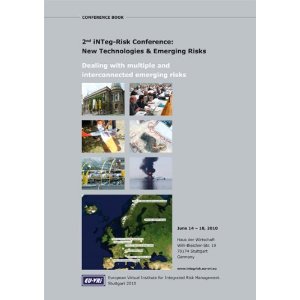 |
The 2nd iNTeg-Risk Conference took place in June 2010. The Conference Book including all abstract, CVs of the speakers and 30 papers is available at Amazon.
Order your copy of the iNTeg-Risk Conference Book following the link.
|
|
|
|
|
|
24 Jun
2010 |
EU-VRi in the annual report of the INERIS |
 |
The INERIS which is one of the founding members of EU-VRi has published in its annual report of 2009 a presentation of EU-VRi with an interview of the Prof. Dr. Aleksandar Jovanovic, its CEO.
EU-VRi in the annual report of the INERIS 2009
“No innovation without control of the risks”
In its annual report 2009 of INERIS which has been recently published, the INERIS presents EU-VRi with in addition an interview of the Prof. Dr. Aleksandar Jovanovic, CEO of EU-VRi.
You can find the report here. (in French)
|
The presentation
The Institut National de l’Environnement industriel et des RISques (INERIS), a founding member of EU-VRi, presents the European Economic Interest Grouping and its different projects with some key figures. Indeed, the presentation gives information about iNTeg-Risk and Alfa-Bird and insists on the fact that EU-VRi approaches its projects in a multidisciplinary way what allows it to work effectively on the emerging risks.
|
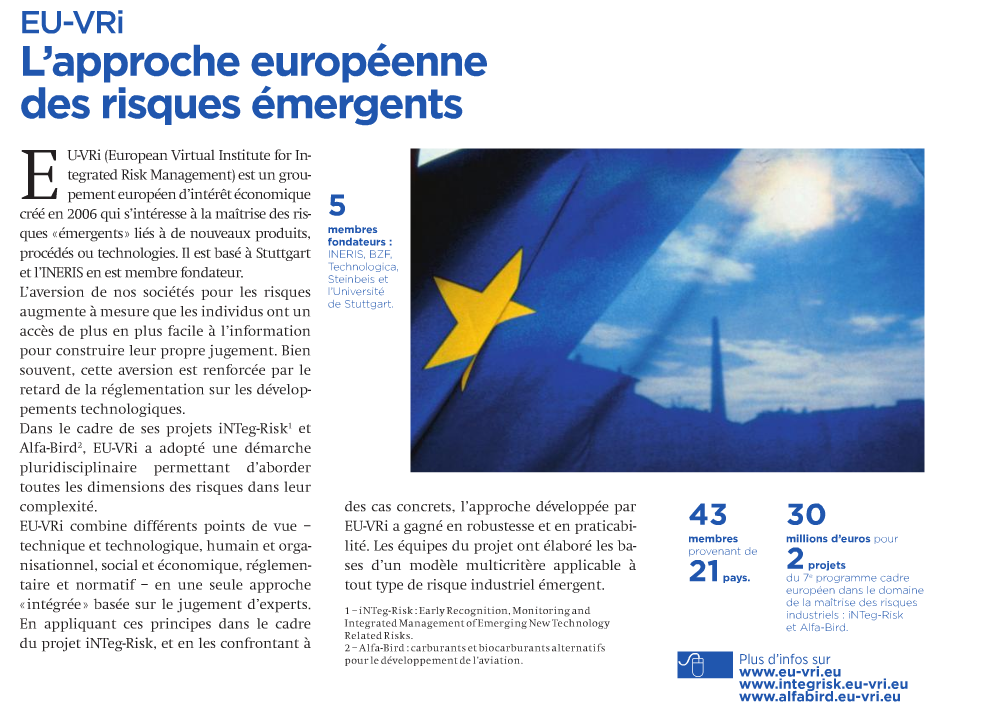
|
|
|
|
The Interview
In the interview which includes a presentation of the Prof. Dr. Aleksandar Jovanovic, the CEO of EU-VRi explains what iNTeg-Risk is and what its goals are.
|
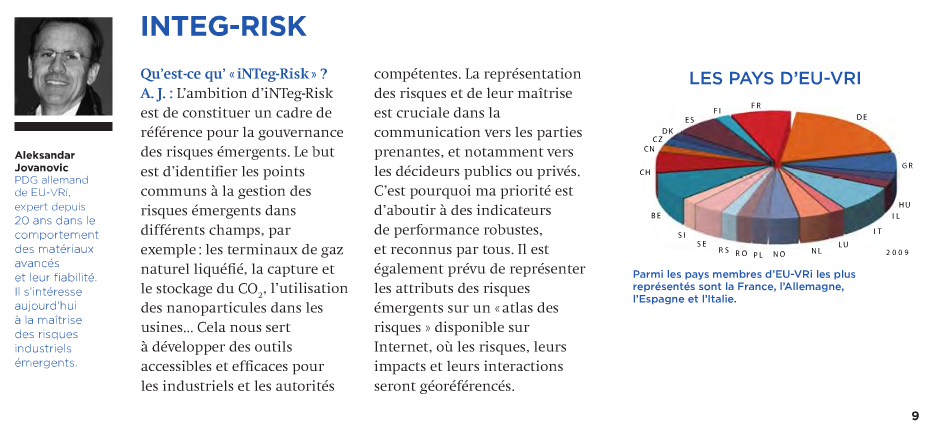
|
For more information about the INERIS:
http://www.ineris.fr/
|
|
|
|
|
|
|
|
24 Jun
2010 |
iNTeg-Risk in the Corporate Responsibility Report of the world’s second-largest reinsurer |
 |
Swiss Re has recently published its Corporate Responsibility Report of 2009, in which we can find information related to the partnership between Swiss Re and iNTeg-Risk.
iNTeg-Risk in the “2009 Corporate Responsibility Report Committed to sustainable value creation” of Swiss Re
In its report, Swiss Re, which is the world’s second-largest reinsurer, explains that its partnership with iNTeg-Risk is one of its strategic initiatives.
|
In cooperation with its external partners, Swiss Re actively contributes to four strategic initiatives dealing with emerging risks. In this way they want to raise awareness of selected emerging risks and support the business community in prioritizing, communicating and managing them.
- WEF - Global Risk Network
- Chief Risk Officer Emerging Risk Initiative
- International Risk Governance Council
For more information about Swiss Re, you can visit its website here
|
|
|
|
|
|
|
|

You can find the pdf of this report just above
|
|
|
|
|
|
|
13 Jan
2010 |
Global Risk Report 2010 |
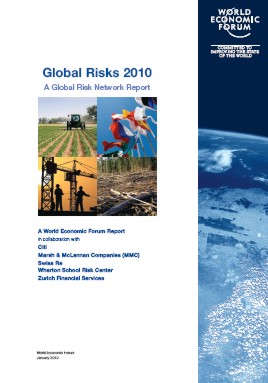 |
Global Risks 2010 - A Global Risk Network Report has been released by A World Economic Forum Report in collaboration with Citi, Marsh & McLennan Companies (MMC) SwissRe, Wharton School Risk Center, and Zurich Financial Services.
Further information and the download can be found on the SwissRe website using the link.
|
|
|
|
|
|
11 Dec
2009 |
Frankfurt and Munich Semantic Web Meetup |
 |
New Frankfurt and Munich Semantic Web Meetup are founded
For those interested in Text-Mining Tasks in iNTeg-Risk (T4.5.2), Marco Neumann, Leo Keller and Martin Hepp (initiators of the Semantic Web community) have created Semantic Web Meetup Frankfurt and Munich in order to act as catalysts.Meetup is the
biggest network of local groups in the world. With Meetup, anyone can
easily organize a local group or find one of the thousands of groups
that already meet in person. More than 2,000 groups meet daily in local
communities. In each of them, the members set the goal of improving
themselves and their community. If you are interested, you can find more informations under: http://www.meetup.com/Frankfurt-Semantic-Web-Meetup/de/http://www.meetup.com/Munchen-Semantic-Web-Meetup/de/ |
|
|
|
|
|
30 Jul
2009 |
Successful Cooperation |
 |
Thorsten Bahke, director of the German Institute for Standardisation (DIN), spoke on the traditional „Steinbeis Day“ last year. In the annual report by DIN, Bahke now emphasises the positive cooperation with Steinbeis.
In the annual report by the German Institute for Standardisation (DIN Deutsches Institut für Normung e. V.) DIN director Thorsten Bahke emphasizes how positive the cooperation between DIN and the Steinbeis Foundation (Steinbeis-Stiftung). The two institutions have been working together for many years now. Bahke was guest at the traditional „Steinbeis Day“ in September 2008. There the DIN director gave a presentation on „Standardisation as a Prerequisite for Success and Sustainability of New Technologies“.  The Steinbeis Day is the event where staff members, associates, clients, students and project partners meet once a year in Stuttgart. On this day Steinbeis offers them and all who are interested to take a close look into the activities, branches and comptences of the foundation in the fields of management and technology. This year the Steinbeis Day will be held on September 25, 2009 at the Haus der Wirtschaft Stuttgart. By the way, DIN director Thorsten Bahke will also speak at the University of Stuttgart on November 11, 2009. His speach is part of the lecture series and is entitled „Standardisation as a Prerequisite for Success and Sustainability in the Process of Innovation“. DIN director Thorsten Bahke will speak at the University of Stuttgart in November. (Photo: DIN)
|
|
|
|
|
|
30 Jul
2009 |
Opportunities are Calling |
 |
On July 10, 2009 the EU-VRi managers organised an internal „EU-VRi Brokerage Event“ in order to prepare EU-VRi members fort he coming call of the Seventh Framework Program (FP7) of the European Community.
On July 10, 2009 the EU-VRi managers organised an internal „EU-VRi Brokerage Event“. The objectice was to prepare EU-VRi members for the coming call of the Seventh Framework Program (FP7) of the European Community. The FP7 will probably be published by the EU on July 31, 2009. The goals of this meeting were to identify common topics of interest, to identify project leaders and, of course, to find out which members are interested in the same projects or topics in order to develop appropriate consortia. Common topics concerning FP7 were found on th "EU-Bri Brokerage Event". (Photo: Michael Nivelet)
The given overview of the FP7 workprogramme and analysis of opportunities included topics such industrial risk and safety, Life Cycle Assessment (LCA) and risk assessment, nanotechnologies, new energy and transport, security, Public Private Partnership (PPP), Factory of the Future, Green Cars or Energy 2 Build (E2B). Furthermore representatives of the EU-VRi informed the participants of the brokerage event on the development of other programmes like ERA-NET (European Research Area) and EUREKA!Industrial Safety. EUREKA is the pan-European network for market-oriented, industrial R&D (research and development). During the event some participants already presented drafts of project ideas based on the information concerning the FP7 workprogramme. At the moment several member groups are working out which calls of the FP7 should be applied for. EU-VRi supports them to formulate the applications. |
|
|
|
|
|
30 Jul
2009 |
Training on Every Level |
 |
The European Virtual institute for Integrated Risks Management considers education in corporate social responsibility as one of their main tasks. Therefore EU-VRi has applied for the Global Reporting Initiative (GRI) Certified Training Program.
„The aim of education is the knowledge not of fact, but of values“, said once the British author, Dean William R. Inge. For the EU-VRi the dissemination of knowledge an important part of their tasks. Thus the education in corporate social responsibility (CSR) is one of their main activities. Therefore EU-VRi - a GRI organisational stakeholder - has applied for the Global Reporting Initiative (GRI) Certified Training Program. This program aims to disseminate knowledge on sustainability reporting around the world. It has been developed especially to help report makers and users to more effectively use the GRI Framework and GRI reports. The minimum 16 hour program ist given by local training partners around the world. Parts of ist objectives are the conceptual introduction and preparation of a GRI reporting process, the dialogue with stakeholders and credibility of the reporting process, defining the content of the report and monitoring, and preparing final reporting and communicating. The EU-VRi and its members offer a broad range on educational and training activities for professionals/post-academics as well as academics. One part of these activities is the project ESPRiT. ESPRiT stands for "Enhancing Industrial Safety, Environmental Protection and Risk Management in Serbia by means of dedicated Training, Education and Technology Transfer“. It is a PPP Project (Private-Public Partnership) which started with the support of Deutsche Investitions- und Entwicklungsgesellschaft mbH (DEG). „Train the trainers“ is one of the ESPRiT objectives: a pool of ESPRiT trainers will be established which might be used as lecturers in second round of ESPRiT courses for certain ESPRiT topics, and/or as R-Tech trainers for the same, specific topics in the future. Participants of ESPRiT courses passed with score higher then 85 percent. Another topic is „On-the-job-training abroad“: 40 persons from Serbian companies are entitled to participate in the short-stay based part and five persons in the long-stay based part of on-the-job training in other countries. The EU-VRi
considers education as one of the most important task. (Photo: ZUMQUADRAT/Fotolia)
The University of Stuttgart, which founded together with Steinbeis Advanced Risk Technologies the EU-VRi, offers a course in iCSR and sustainability report. It is held at the ZiRN, the "Interdisciplinary Research Unit on Risk Governance and Sustainable Technology Development" which itself is part of IZKT, the "International Center for Cultural and Technological Studies" of the Stuttgart University. The course iCSR stands for integrated Corporate Social Responsability and it integrates the "classical" CSR with the relevant technology and financial aspects in order improve sustainability of long-term CSR stratetegies and their successful implementation. Instead of only dealing with social and business aspects, the iCSR integrates the technology and economy-related aspects into CSR e.g. the issues like HSE (Health, Safety, Environment), “integrated” risk management issues (IRM), and/or “the emerging” risks. This program is about to be expanded in the framework of the above mentioned GRI training program. Whereas the University of Stuttgart, ZIRN, is responsible for the academic education in the field of CSR, in respective GRI courses, the Steinbeis Advanced Risk Technologies is in charge of the professional education in the field of CSR. Thus the EU-VRi benefits from the competences of its two Founding Members, the University of Stuttgart (ZIRN) and Steinbeis Advanced Risk Technologies GmbH and is targeting two groups of persons with different background and knowledge on the field of Corporate Social Responsibility: students and professionals. Beside the academic education within the structure of the University of Stuttgart, EU-VRi offers courses and workshops to professionals, who already have a broader understanding about general concepts of CSR. The main focus has been on the management of technological risks and the handling of innovations. Apart from the students, the course involves up to several hundred stakeholders in the area of CSR. Its results have raised a lot of interest and led to direct support by, e.g. large industry (Bayer, BASF, Ernst & Young, …). Of particular interest are the “hot CSR topics” such as climate change, energy security supply, intercultural aspects of work in “global” companies, and CSR and terrorist threats in working environment (company security). The participants benefit from fruitful cooperation with industry, NGOs and governmental bodies as well as from invited lecturers taking into account current developments in the field of CSR (e.g. ISO 26000). The students learn how to assess and interpret the differences in the opinions of stakeholders’ groups ranging from corporate executives over union members, government officials to entrepreneurs. |
|
|
|
|
|
30 Jul
2009 |
Searching for the Key |
 |
An essential part of the project iNTeg-Risk is to develop comprehensive so-called
Key Performance Indicators (KPIs). Now the Project Work for KPIs has started.
One cornerstone of the project iNTeg-Risk is to develop comprehensive
Key Performance Indicators (KPIs) to be able to evaluate the issues of
industrial safety on a European level. However, over many years
different branches have built up and used their own KPIs according to
their needs. But the question is, are there efficient KPIs which can be
used comprehensively? To develop overall KPIs, the different methods
and tools of measurement being already used by different branches in
the field of industrial safety have to be discussed, evaluated and
selected.
In two workshops members of the project inTEg-Risk as well as
representatives of the industry started to work on these KPIs. The
first workshop took place in Beitostølen, Norway, from April 20 to 22,
2009. There it was agreed that the participants need to build upon,
extend and share intensively the mutual knowledge during the coming
period. In addition to that the importance of common understanding of
KPIs, CSR (Corporate Social Responsibility), and sustainability was
emphasized, nevertheless it still has to be argued on how to insert
these aspects into the theme of risk analysis, i.e. iNTeg-Risk. So far,
a framework has been set on deliverables, final drafts and man months. Conerning KPIs a timeline has been set for deliverables, final drafts and man months. (Photo: JoLin)
The second workshop on KPIs was held during the first iNTeg-Risk Conference in Stuttgart on June, 4 2009. There the different approaches of the industry were introduced. For example Gerhard Kuhn from BASF SE, Ludwigshafen, Germany, presented the safety management systems covering for example workflow, SHE reviews (Safety, Health, and Environmental Solutions) or training, and gave an insight into audit systems. According to his opinion, the application of new indicators in order to enhance safety performance seems sensible. On the other hand, Alexandar Jovanovic, EU-VRi European Virtual Institute for Integrated Risks Management, and Reto Schneider, Swiss Reinsurance, pointed out how the consent on the usefulness of KPIs and SPIs (safety performance indicators) is very often challenged by the lack of internationally accepted standards. Other challenges are the inconsistency of higher-level indicators, e.g. indicators dealing with CSR or business continuity, and the incompatabilities of indicators in different branches. Reto Schneider, Swiss Re, presenting his speech on the first inTEg-Risk conference in Stuttgart.(Photo: Mostbacher-Dix)
Enlightening for sure was Reto Schneiders presentation on the usefulness and the necessity of KPIs from the point of view of insurances. Discussed as well were how KPIs can be implemented technically in the field of new technologies. Several presentations dealt with concepts of Emerging Risk Representative Applications (ERRA). For example talked Chabane Mazri, Bastien Affeltranger and Mathieu Reimeringe, all INERIS, France, about the rational and practical application to NaTech Risks, or Henning Boje Andersen and Thomas Thommesen from the DTU Technical University of Denmark explained the challenges which are posed to safety by outsourcing critical tasks in the oil, gas, petrochemical and construction industries. |
|
|
|
|
|
15 Jul
2009 |
Ensuring Peer Support |
 |
After the first iNTeg-Risk Conference in Stuttgart from June 2 to June 3, 2009, the members of the international advisory board (IAB) came together to discuss the objectives of the project and the future workplan, as well as to select a rapporteur.
In the course of the first iNTeg-Risk Conference, also the members of the International Advisory Board (IAB) came together for a meeting. They gathered in the historic tower room at the Haus der Wirtschaft to review the projects objectives as well as the future workplan. The members of the International Advisory Board (IAB) at the first iNTeg-Risk Conference. (Photo: Mostbacher-Dix)
The IAB consists of 27 persons from different backgrounds. The members
come from branches such as research, development, industry or politics.
The IAB tasks are to view the project from an external angle and to
give advice. Furthermore it is responsible for the dissemination of the
project’s objectives, goals and outcomes. At the Stuttgart meeting
Jean-Paul Lacoursiere (University of Sherbrooke, Canada) was elected as
chairperson of the IAB, Jan J. Meulenbrugge (TNO Built Environment and
Geosciences, Netherlands) was chosen to be the rapporteur.
In short talks the members presented their important notions concerning
the activities and features of iNTeg-Risk, as well as the critical
points which might need specific measures or actions, or
recommendations. Thus was suggested to involve more practitioners from the industry into
the procedures or to provide parallel sessions in following
conferences. Nevertheless, all agreed on how the programme had been set
up. As it was the first iNTeg-Risk Conference ever it had been
important that all participants were in the same presentations, they
said, in order to get to know each other and their particular issues.
The second iNTeg-Risk Conference will be held from June 15 to June 17, 2010, in Stuttgart. |
|
|
|
|
|
21 Jun
2009 |
Conjuring up the Team Spirit |
 |
The First iNTeg-Risk Conference ever which was held from June 2 to June 4, 2009 in Stuttgart was a success. About 250 participants from 28 countries took the opportunity to meet in order to find guidelines how to create a safer world.
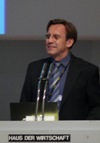
Prof. Jovanovic, project coordinator and CEO of EU-VRi, welcomes the participants at
the 1st iNTeg-Risk Conference.
|
|
For a long time Stuttgart and its surroundings has been known for being
the cradle of pathbreaking technologies - thanks to its numerous
inventors and universities, big businesses or multinational companies.
The State of Baden-Württemberg still belongs to the regions with the
highest patent applications in Europe. Thus it was appropriate
that the first iNTeg-Risk Conference took place at the Haus der
Wirtschaft in Stuttgart from June 2 to June 4, 2009. And to cut a long
story short: This first conference dealing with the intergrated risks
of new technologies was a success. Altogether about 250 participants
from 28 countries around the world listened to 57 state-of-the-art
presentations in the conference and the post-conference workshop. The
schedule was considerlingly tight, of course, nevertheless the
discussions after some presentations, in break times or especially in
der workshop showed how highly motivated and interested the
participants were. According to the concluding survey project partners
and external participants equally appreciated the conference as well as
its fringe events highly. 92,5 percent of them rated the organization
of the iNTeg-Risk support team as a great success. Especially the conference
book and the updated list of attendees were praised. Some
participants suggested that there should be more time for questions at
the second day or parallel sessions. Nevertheless, all participants
agreed on the good quality of the iNTeg-Risk Conference as it was the
first of its kind ever. Almost all of them went home with a positiv
general impression.
|
Around 250
participants were paying attention to the state-of-the-art
presentations.
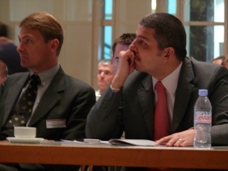
|
|
After all, there had to be subjects tackled from a broad range of
technology territories. The spectrum variied from detailed themes like
healthy workplaces and tools in nanotechnology applications, over
broader approaches such as corporate responsibilities and public
perception on technology, finally up to a global perspective like the
OECD’s efforts to harmonize safety and risk indicators or the
governments’ expectations in R&D projects. Also the tricky subject
of finding so-called „Key Perfomance Indicators“ (KPIs), which shall
set European standards for how to detect and go on about emerging
risks, was addressed and especially in the post-conference workshop
discussed. Naturally, nobody expected on the fist conference that KPIs
would be found on which all should agree on. The subject is approached
differently from country to country, from industry to industry.
Important was here as in the other areas that participants from
different fields such as industries, science, education or government
exchanged their knowledge in order to find a common basis. Or as the
former Project Officer for iNTeg-Risk Søren Bøwadt, who works for the
European Commissions Research Directorate for Industrial technology in
DG research, put it: „This Conference is about the team spirit! The 20
Million Euro project line is there to set the scene for the iNTeg-Risk
project in order to find guidelines. It is a lifetime chance to make a
difference to create a safer world!“
Left: The Project Officers for iNTeg-Risk Søren Bøwadt and Antonio Cipollaro are listening to the presentations.
(All photos: Mostbacher-Dix)
|
|
|
|
|
|
|
14 May
2009 |
New EC Project Officer for iNTeg-Risk |
 |
We are glad to inform you that the new EC Project Officer for iNTeg-Risk was introduced to the Coordinator and to the Executive Board at the meeting in Brussels on May 13, 2009.
Antonio Cipollaro will take over the duties from Soren Bowadt, the current Project Officer for iNTeg-Risk, after a transition period where both will be in charge of the project from side of the EC. To inform yourself more about Mr. Cipollaro and his previous work, please read his short CV. Antonio Cipollaro (short CV) 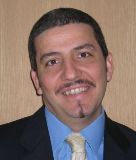 Antonio CIPOLLARO holds a Master of Science degree in Nuclear Engineering attributed by the University of Pisa (Italy) with a specialization in Innovative Nuclear Power Plants (NPP). After a half year experience working for the Science & Technology Center of Westinghouse Electric Company in Pittsburgh, Pennsylvania (USA) in charge of the preliminary safety assessment of the Generation IV NPP IRIS, he has been engaged by Tractebel Engineering (GDF SUEZ) in the Safety Assessment & Operation Division of the Nuclear Department. Here he was mainly dealing with safety studies analyzing Design Basis Accidents, Emergency Operating Procedures and Severe Accidents Management Guidelines validation interacting with the Belgian Technical Safety Organization (Bel-V) and providing specific training to NPP control room and crisis team staff. He was member of the external team supporting the crisis team in case of emergency plan activation. He is member of the Belgian Nuclear Society and of the Italian Association of Professional Engineers. Beginning of May 2009, he joined the European Commission in the Directorate for Industrial Technology of DG Research, where he is responsible for research activities dealing with safety in processes and products. |
|
|
|
|
|
08 May
2009 |
French Ambassador and French Consul General in Stuttgart visit Steinbeis and EU-VRi |
 |
On May 8, Bernard de Montferrand, French Ambassador in Germany, and
Christian Dumon, French General Consul in Stuttgart, visited Steinbeis
and EU-VRi.
On May 8, Bernard de Montferrand, French Ambassador in Germany, and Christian Dumon, French General Consul in Stuttgart, visited Steinbeis and EU-VRi. In his welcome Prof. Löhn, President of Steinbeis University explained in details the concepts of the transfer of technology from academics to industry implemented in a successful manner by Steinbeis. Further information was provided by Mr. Haug, especially about the network of Steinbeis. Prof. Jovanovic, CEO of EU-VRi and director of Steinbeis Advanced Risks Technologies, and Mr. Salvi informed the visitors about the work performed by EU-VRi, initiated thanks to the strong cooperation between Steinbeis and INERIS. The model of Steinbeis might be inspiring for the French institutions and government to develop similar initiatives in France. Mr. Christian Dumon, Mr. Bernard de Montferrand, Prof. Johann Löhn,
Prof. Aleksandar Jovanovic, Mr. Olivier Salvi, Mr. Uwe Haug (from left)
|
|
|
|
|
|
30 Dec
2008 |
iNTeg-Risk contract is signed by the European Commission |
 |
The signed iNTeg-Risk Grant Agreement No 213345 is available for all partners (main beneficiaries).
|
|
|
|
|
|
25 Nov
2008 |
iNTeg-Risk open users' forum |
 |
The open forum "How to use the project management tool" took place on Nov. 24, 2008.
The participants of the open forum "How to use the project management tool" had the chance to interact in the teleconference, while seeing on their screen the relevant presentation. The users were informed about the iNTeg-Risk web tool and received solutions to their problems. The representatives of the partners that participated in the teleconference can be found in the following list: - D.Balos (R-Tech)
- A.Jovanovic (EU-VRi)
- S.Jovanovic (EU-VRi)
- O.Salvi (EU-VRi)
- R. Kokejl (R-Tech)
- C.Böhm (GDS)
- R.Bubbico (UNIRM)
- P.Heikura (Pöyry)
- H.Ingason (SP)
- F.Leismann (STUVA, on behalf of R.Leucker)
- M.Löscher (R-Tech)
- D.Loutas (TU Crete, on behalf of G.Papadakis)
- K.Oien (SINTEF)
- C.Schmidt (Definiens)
- M.Ström (Swerea IVF)
- G.Xenikakis (R-Tech)
- J.H.Zheng (Technologica)
Below is the agenda of the teleconference and the participants' responses: 1. Why do I have to log in? May I give my credentials to my colleague? How do I log in?
Credentials are absolutely personal. In case that a person from your company should also have access to the tool, please contact iNTeg-Risk support team (integrisk@eu-vri.eu) giving FULL contact details.
2. Where is the proposal? Where can I find other documents?
Useful documents can be found by clicking "My documents" on the left pane menu. Do not forget that documents are connected to tasks. For help consult the iNTeg-Risk support team.
3. Which are my tasks?Click on "My activities" on the left pane.
Q: Where can I find the number of travels?
A: Number of travels is just a basis for defining the travel budget. The overall travel budget is distributed over the tasks. What really counts is the OVERALL bugdet.
4. Which persons work on my tasks? How can I add more people?see above
5. What are the resources, deadlines and deliverables for my tasks?
Click on "My Activities" and then on the respective task. Check how much money you can charge and from whick point on. For large tasks more than one person can manage the Man-Months. For new persons added to the task, the procedure of point 1 should be followed. The consortium decides for the confidentiality of the deliverables.
6. Timesheets- why do we need them? How do I do bookkeeping?
Timesheets are irrelevant with bookkeeping according to the partner's country law. They are introduced as a form of auditing. Timesheets are given in hours and can be approved through several levels (SP/WP/Task leaders)
7. Acceptance and signatures
Discussion
C.Schmidt: The web tool is useful for iNTeg-Risk. All tasks can be found at once
F.Leismann: Are timesheets a way of bookkeeping? A: Timesheets are invention of the EU-they do not interfere with the country's law
D.Loutas: Reported problems with the teleconference. A: A questions & answers transcript will be created.
R.Bubbico: Web tool is flexible and useful. Teleconference quality should be improved.
J.H.Zheng: Teleconference can save money. Video-conference should also be considered. A: Expensive technical equipment is needed.
K.Oien: Teleconference is new experience. Further action should be considered.
M.Ström: Suggested conventional teleconference in parallel with a screen sharing utility.
A.Jovanovic: Questionnaire about the acceptable means of teleconferencing will be created.
|
|
|
|
|
|
25 Nov
2008 |
iNTeg-Risk officially commences on Dec. 1, 2008 |
 |
Start date of the project is fixed and agreed among partners and EU
25.11.2008
The whole iNTeg-Risk team is glad to announce that the project has adopted Dec. 1, 2008as its fixed starting date. The European Commission has agreed to this date and the final version of the grant agreement should be expected in the nearest future.
|
|
|
|
|
|
24 Nov
2008 |
iNTeg-Risk informational leaflet |
 |
The updated version of the iNTeg-Risk leaflet is now available
25.11.2008
Version 3.0 of the iNTeg-Risk informational leaflet, which includes the most up-to-date data is now available here  for downloading. The leaflet presents the main partners of the project, as well as the basic idea, objectives, structure and its planned achievements. |
|
|
|
|
|
03 Oct
2008 |
R-Tech participation in ESREL 2008 |
 |
R-Tech was active at the joint ESREL 2008 and 17th SRA-Europe Conference, held on Sept. 22-25 in Valencia, Spain.
The lecture of Prof. Dr.-Ing. Aleksandar Jovanovic with subject "Practical steps towards sustainable use of safety performance indicators in EU industry" was presented at the ESREL 2008 Conference, which was organised by the European Safety and Reliability Association (ESRA) and took place in Valencia, Spain on September 22-25, 2008.
Prof. Jovanovic introduced the current projects and activities of Steinbeis Advanced Risk Technologies (R-Tech), as for example the innovative Key Performance Indicators (KPI) database, the EU project iNTeg-Risk and the goals of the European Virtual Institute for Integrated Risk Management (EU-VRi).
ESREL conferences are principal European fora for presentation and discussion of scientific and technical papers covering safety, reliability and risk-based methods as well as their application in a wide range of industrial and governmental sectors.
|
|
|
|
|
|
02 Oct
2008 |
Steinbeis collaboration with DIN |
 |
Steinbeis collaborates with DIN on standardization of "new technologies"
The lecture of the DIN director Dr. Bahke on the Steinbeis Day was the first step towards a close cooperation, which was established in the summer of 2008 between the Chairman of Steinbeis Foundation Prof. Dr. Trasch and Dr. Bahke. At a following stage and during the next years, CEN-Workshop Agreements (CWA) are going to be prepared through a European research project with subject "Early recognition and management of new technology related risks", under direction of Prof. Dr.-Ing. Aleksandar Jovanovic.
As stated at the web-site of the German Institute for Standardization (DIN), on the 19th of September during his lecture Dr. Bahke has informed the audience about “Standardization as prerequisite for the success and sustainability of new technologies” and stressed out the positive collaboration between Steinbeis and DIN.
“An early care for standardization in the research process and especially for the interpretation of results concerning state-of-the-art technologies can offer an advantage to Germany”, said Dr. Bahke. The audience was particularly interested in the use of standardization in research projects and new innovative fields, as well as in the value of standards in technology transfer.
Steinbeis day is the meeting point of colleagues, students and project partners of the Steinbeis Foundation (http://www.stw.de). Most of the directors of transfer centers are professors at universities.
|
|
|
|
|
|
07 Jul
2008 |
Legal Entity Appointed Representative (LEAR) |
 |
A legal signatory of each legal entity must appoint one person (the so-called LEAR – Legal Entity Appointed Representative) for being the correspondent towards the Commission on all issues related to the legal status of the entity.
A legal signatory of each legal entity must appoint one person (the so-called LEAR – Legal Entity Appointed Representative) for being the correspondent towards the Commission on all issues related to the legal status of the entity.
The LEAR provides the Commission with up-to-date legal and financial data (including supporting documents, where necessary) and commits to maintain the information up-to-date, enabling future use for grants and other transactions between the entity and the Commission research (and other) programmes.
The LEAR communicates his/her role internally in his/her organisation and provides the PIC to other employees dealing with proposals and grant agreements.
If your organisation has not yet appointed a LEAR, then click here to go to the European Commission web page and appoint one person of the entity.
|
|
|
|
|
|
|
|